
SPRING/SUMMER 2022 VOL. 93 NO. 3
24 Hook, Line, and Sinker
Pickard Theater returned to life this spring with a vibrant and beautiful musical based on the myth of a water creature who assumes human form.
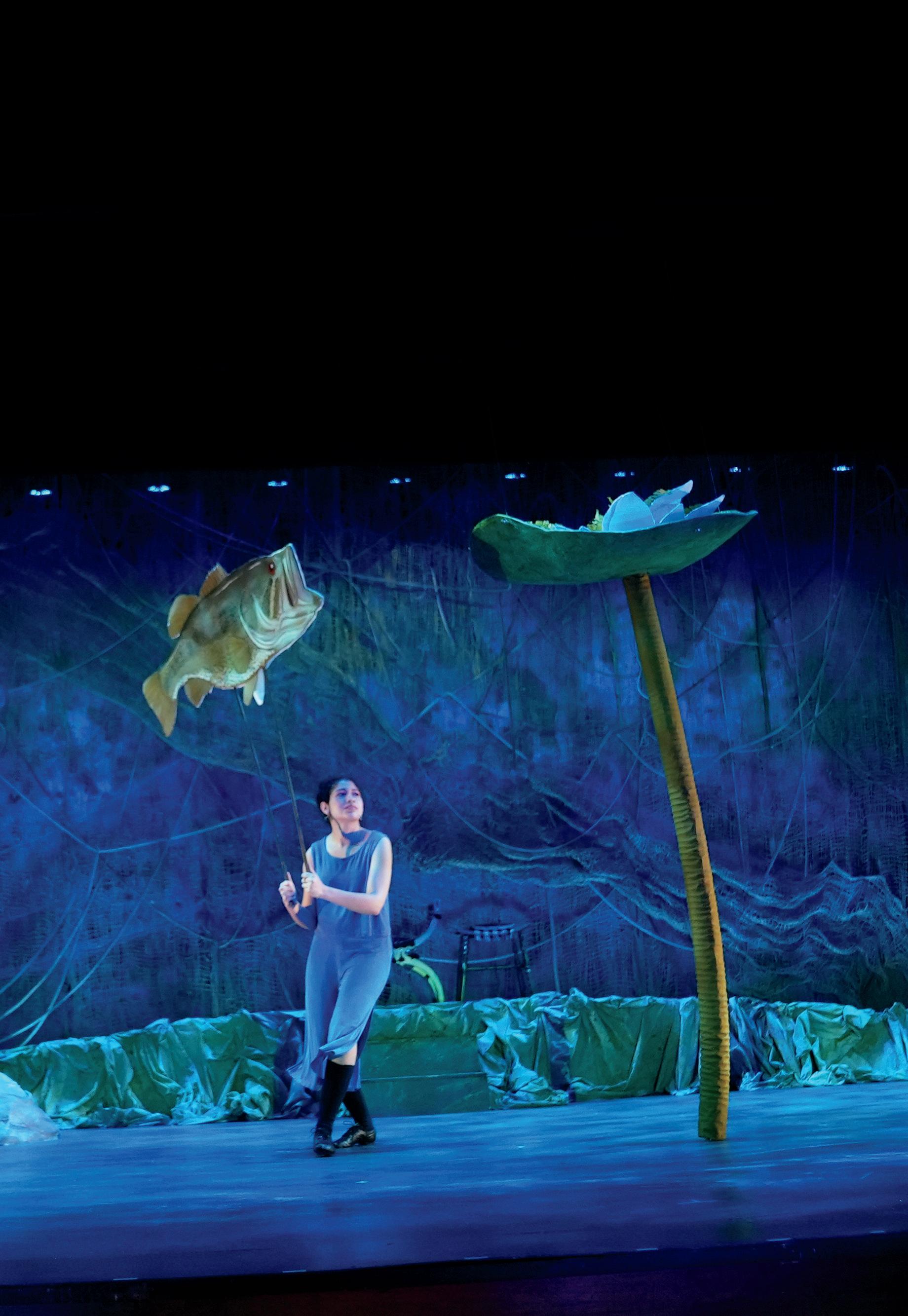
32 For the Sake of Honor
Bowdoin made history on May 28 when— for the first time in 217 Commencement ceremonies—it presented all of the honorary degrees to women.
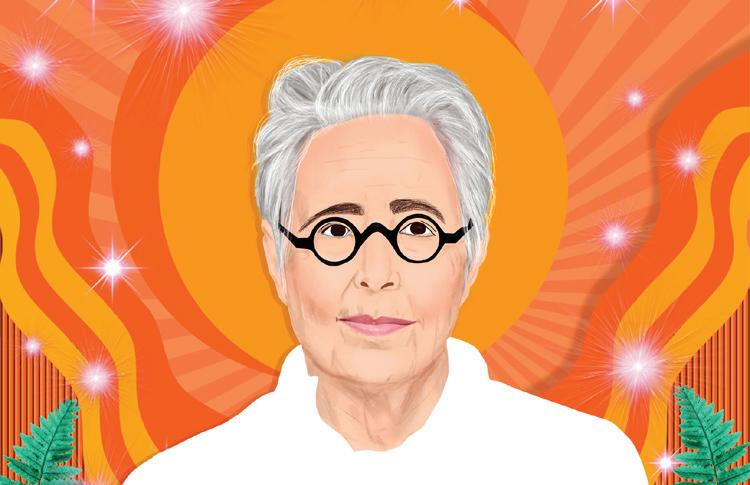
44 Growing up NESCAC
From coach’s son to undersized lineman to professor of sport management, Dan Covell ’86 has been steeped in the New England Small College Athletic Conference.

50 Q&A
Preston Anderson ’22 skippered a national initiative that is changing collegiate sailing.
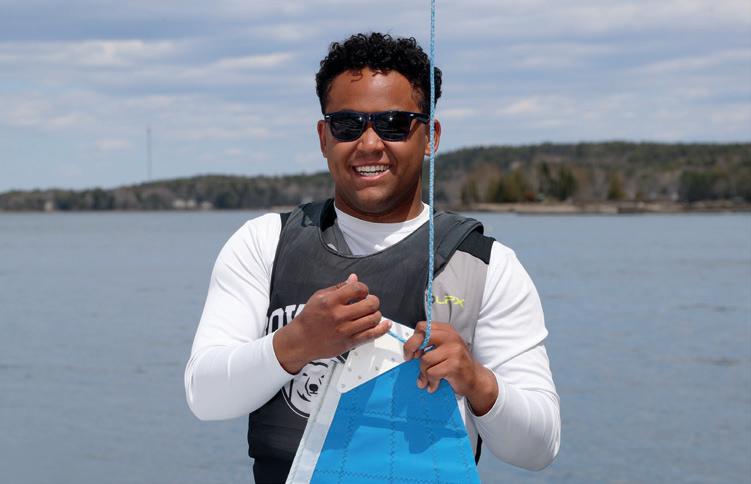
SPRING/SUMMER 2022 VOL. 93 NO. 3
Contents
“Helplessly, hopelessly, head over heels in love. Hook, line, and sinker— that’s the only way to fall in love.”
5 Always Looking Forward: Liddy Berry ’75, P’05 submitted the first formal application to Bowdoin when the College officially opened to women students.
7 Dine: Blueberry cake from Ned Horton ’82, P’24 and Julie Bertola Cook ’82.
8 Benthic Ecology: Students deepen their research at the Schiller Coastal Studies Center.

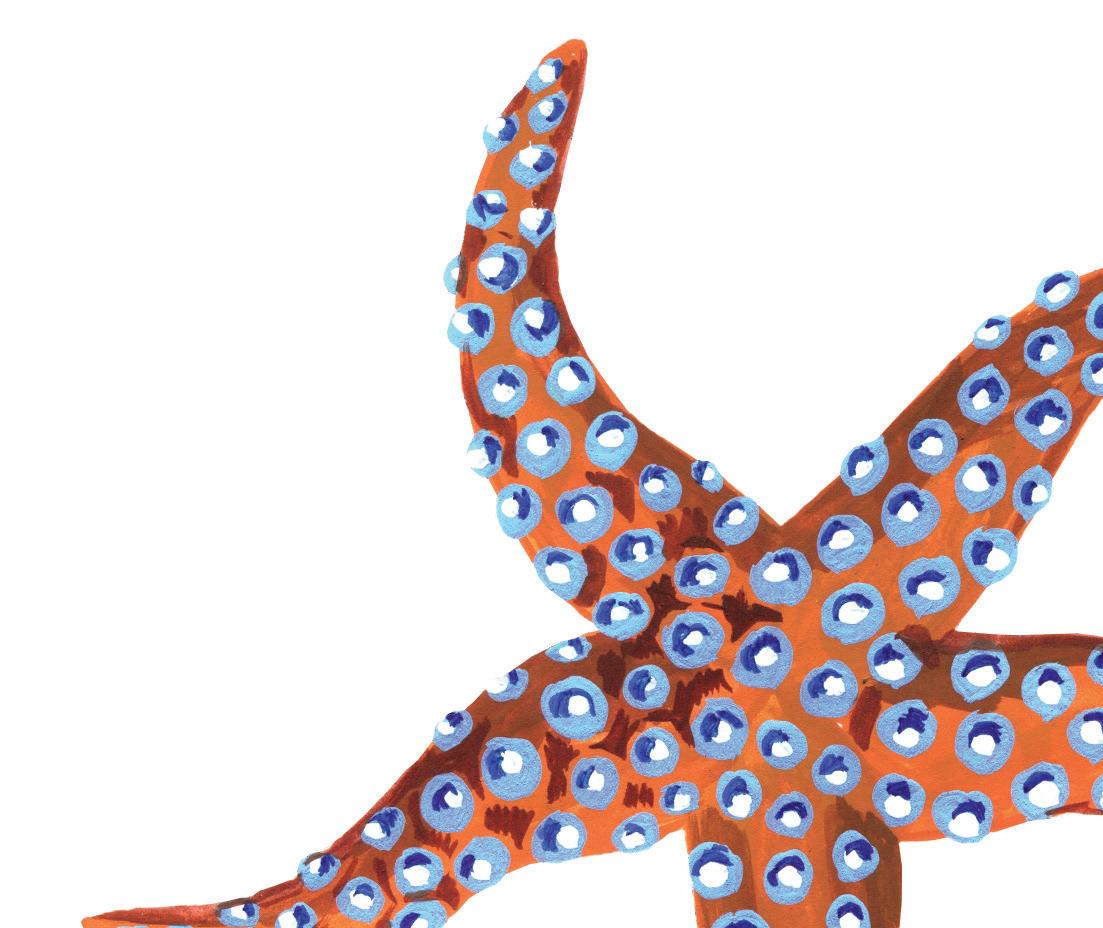
17 Well Understood: CityMusic Cleveland performed the poetry of Weatherspoon ’25.
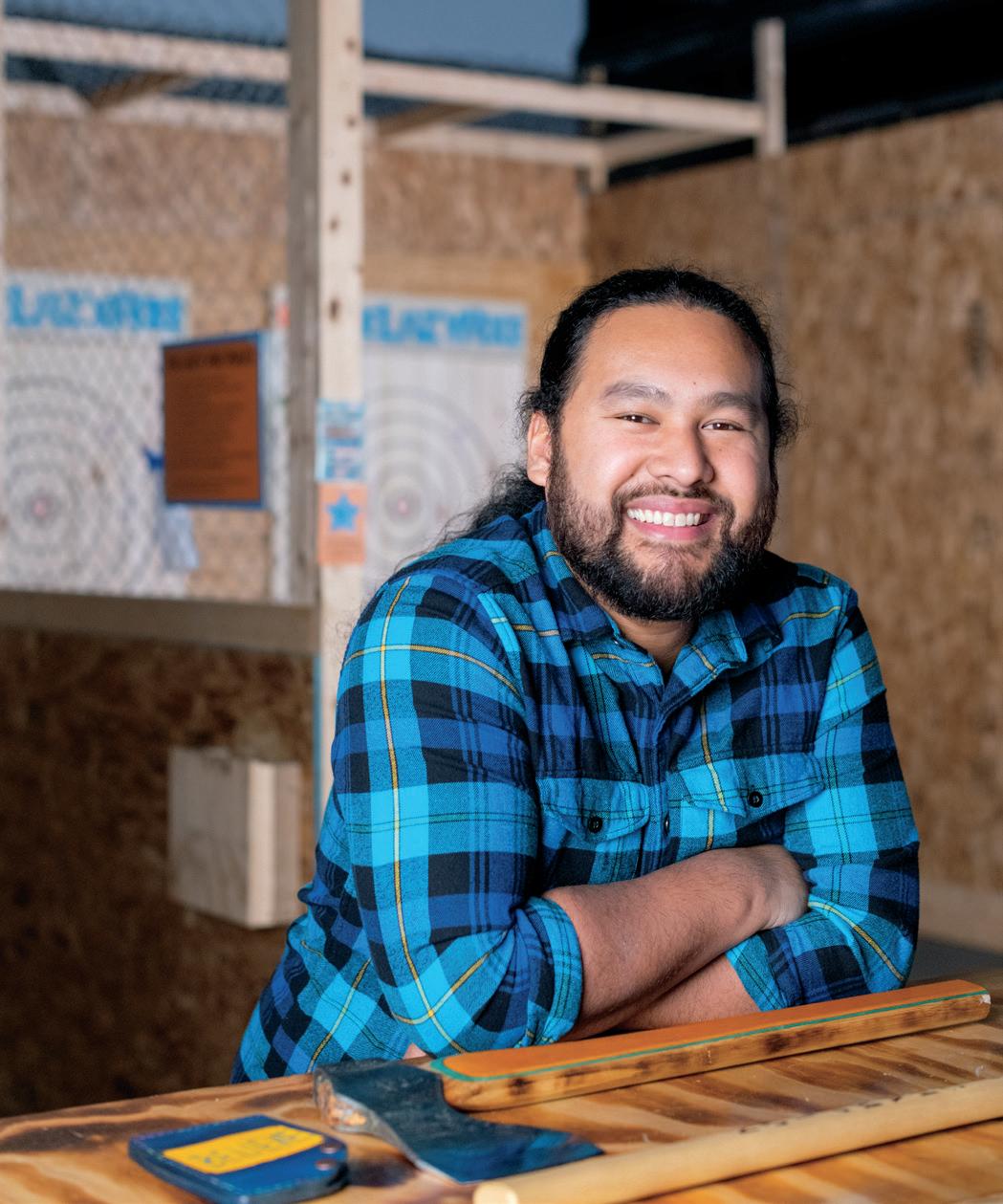
21 Project ’72: Long-lost photos from the time Whittier Field transformed into Olympus.
22 Book Club: Emily Cohen ’20 and classmates started a virtual book club to stay in touch. In the end, they were surprised where it took them.

BOWDOIN MAGAZINE SPRING/SUMMER 2022 | CLASSNEWS@BOWDOIN.EDU 1
Column
Connect In Every Issue 53 Mark Mirasol ’10 holds the title of “axe master.” 56 Dave Gleason ’70 on a hometown Reunion. 62 Mariya Ilyas ’13 finds her calling. 4 Respond 52 Whispering Pines 64 Here
Forward
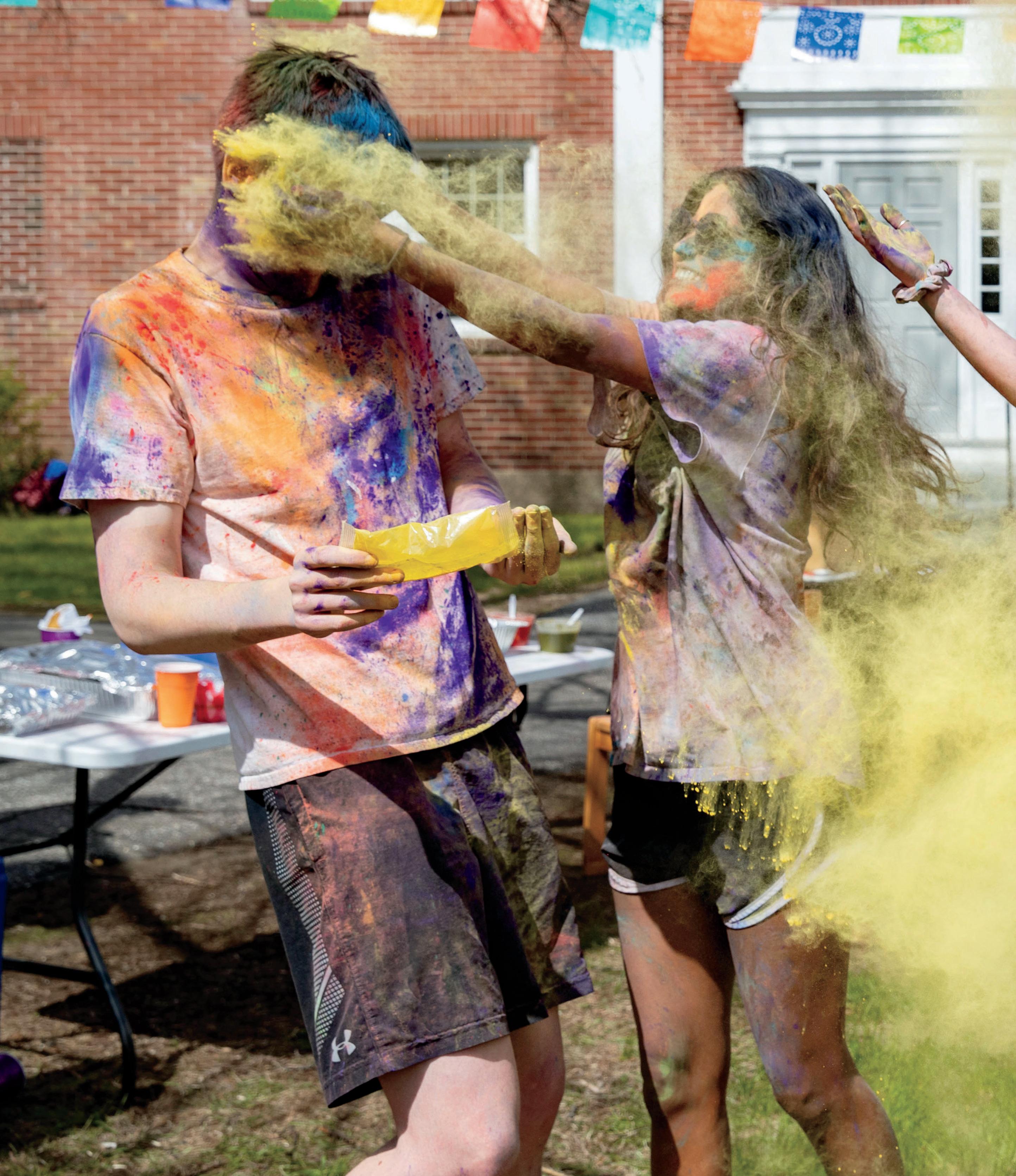
 On Saturday, May 7, students gathered on the Brunswick Quad for Holi, an ancient and hopeful Hindu festival that celebrates the colors and promise of springtime. The South Asian Students Association sponsored the event, which offered samosas, kulfi, gelato, tag, water fights, and a plethora of colorful dance and revelry.
Photo by Andrew Estey
On Saturday, May 7, students gathered on the Brunswick Quad for Holi, an ancient and hopeful Hindu festival that celebrates the colors and promise of springtime. The South Asian Students Association sponsored the event, which offered samosas, kulfi, gelato, tag, water fights, and a plethora of colorful dance and revelry.
Photo by Andrew Estey
TRIUMPH
I’m an American expat who has lived in or near Bangkok for the past thirty years. I could hardly believe my eyes when I read the saga of Mai Libman ’00 in your Winter 2022 issue. My hat is off to Mai for… her skill in spinning what could have been a tragedy into a triumph.
William Page ’60
Cloud Nine
Bowdoin Magazine is one of seven alumni magazines I receive on a regular basis, and I feel compelled to write to you because it is just beautifully put together. The writing is top-notch, the articles and visuals are interesting, and the design clarifies and entertains. I loved the recent “cloud” covers (front and back) and the graphic “look at the lions” piece. Honestly, it is the only alumni magazine that I sit down and read, rather than just flip through. You all deserve kudos for a terrific piece of work!
Joyce Sidman ’06
ALUMNI SOCIAL
Bowdoin’s social media feeds provide fun, entertaining, and informative ways to keep tabs on the College and keep in touch with campus and alumni life, including these popular channels:

linkedin.com/school/ bowdoin-college/people/ @bowdoincollege @bowdoinalumni @GoUBears
MAGAZINE STAFF
Editor
Matt O’Donnell P’24
Consulting Editor
Scott Schaiberger ’95
Executive Editor
Alison Bennie
Associate Editor
Leanne Dech
Designer and Art Director
Melissa Wells
Design Consultant
2COMMUNIQUÉ
Contributors
Jim Caton
Doug Cook
Cheryl Della Pietra
Rebecca Goldfine
Scott Hood
Micki Manheimer
Tom Porter
On the Cover: Illustration by Lyne Lucien ’13.
BOWDOIN MAGAZINE (ISSN: 0895-2604)

is published three times a year by Bowdoin College, 4104 College Station, Brunswick, Maine, 04011. Printed by Penmor Lithographers, Lewiston, Maine. Sent free of charge to all Bowdoin alumni, parents of current and recent undergraduates, members of the senior class, faculty and staff, and members of the Association of Bowdoin Friends.
SEND US YOUR NEWS!
If there isn’t a class news entry for a class year, it’s because we didn’t receive any submissions for that year. We want to hear from you, and so do your classmates! Email classnews@bowdoin.edu or fill out a class news form on our website, bowdoin.edu/magazine.
facebook.com/bowdoin facebook.com/bowdoinalumni facebook.com/bowdoinathletics
@bowdoincollege
@bowdoinalumni
@GoUBears
bowdoin.switchboardhq.com
Opinions expressed in this magazine are those of the authors.
Please send address changes, ideas, or letters to the editor to the address above or by email to bowdoineditor@bowdoin.edu. Send class news to classnews@bowdoin.edu or to the address above.
4 BOWDOIN MAGAZINE SPRING/SUMMER 2022 | CLASSNEWS@BOWDOIN.EDU Respond
LIDDY BERRY ’75, P’05
ALWAYS LOOKING FORWARD
I still have the note from Dick Moll. Bowdoin has a copy, too. I remember the fuss my father (Richard Berry ’45), uncle (Harrison Berry Jr. ’45), and brother (Richard Berry Jr. ’68) made. For me it was just a next step in my intent to study at Bowdoin. I was comfortable in that first class of women. I learned from my experience entering Bowdoin that something can happen even if it hasn’t been done before.
After Bowdoin, I enrolled in the master’s program in special education at the Peabody School of Education at Vanderbilt University. The Education for All Handicapped Children Act was passed by Congress in 1975, so my timing was perfect to enter the field of working with children with disabilities. Currently, I’m an adjunct faculty member in the education department at Worcester State University supporting the next generation of early childhood educators. There is an opportunity to make a difference every day as a teacher. When working with children with disabilities you have to be an optimist—have to believe tomorrow can be better than today.
When I was a child, my father would sing us songs at bedtime. By age ten, I knew all the words to all the Bowdoin songs. We wore Bowdoin sweatshirts and baseball caps, ate on Bowdoin plates, and sat in Bowdoin captain’s chairs. My grandfather (Harrison Berry) graduated in 1911, and I do not think he could have imagined a world where his great-granddaughters—my daughter, Carly Knight ’05, and niece, Yongyai Berry ’96—would be Bowdoin graduates. He would have been so proud.
I married Roy Knight ’75 in the Bowdoin chapel. Our fathers wore Bowdoin ties. Bowdoin runs deeply through all parts of my life.
For more of our interview with Liddy, visit bowdoin.edu/magazine.
In a note dated October 12, 1970, admissions director Dick Moll wrote to Elissa “Liddy” Berry ’75 to recognize and congratulate her as the first woman to submit a formal application to Bowdoin when the College officially opened to coeducation.
 PHOTO: CIDGY BOSSUET
PHOTO: CIDGY BOSSUET
Forward
FROM BOWDOIN AND BEYOND
A Nerd’s Approach
TOM LEUNG ’96 hosts Nerds for Humanity, a weekly YouTube show featuring discussions with politicians and experts—including some members of the Bowdoin community. Leung launched the show in 2020 initially to support Andrew Yang’s presidential campaign. “At the time, I was working at YouTube, and part of my job was to understand the experiences that creators have.” When Yang dropped out of the race, Leung decided to keep going with his show to continue exploring ideas fueling policy debates. The long-form conversations are meant to be an antidote to the daily diet of clickbait headlines and opinionated voices we regularly experience in our online lives. “I think one of the interesting things about media today is that the ones who know the most about something rarely get the most airtime,” Leung said.
Nerds for Humanity focuses on policy and politics and professes a love of charts and graphs. “I try to unpack policy debates with more detail and evidence,” said Leung, who describes himself as a “solutions-focused Independent with a love for the scientific method and coming up with data-driven fixes to complex problems.” Part of the charm of the program comes from the opener, when each guest greets listeners with a personal interpretation of “Hello, nerds!”
Over the past year, Leung has invited five Bowdoin professors to join him on the show, including Thomas Brackett Reed Professor of Government Andrew Rudalevige, Assistant Professor of Government Maron Sorenson, Professor of Government Michael Franz, Professor of Economics Erik Nelson, and Professor of Government Jeff Selinger. Yordana Gerdzhikova ’23 and Phil Sanchez ’96 have also made appearances.
For more about Leung and to link to his show, visit bowdo.in/leung.

Campaign
CELEBRATING WOMEN
On June 30, 2022, the College ends a year of recognizing and celebrating the extraordinary contributions of women to Bowdoin, their communities, and the larger world. Over the course of the year, gifts from women and gifts that honor women have had an important impact on fundraising. A fund created by Katy Longley ’76, Callie Curtis ’72 and Randy Curtis ’72, and Mary Herman that honors Joan Benoit Samuelson ’79, P’12, and another established by Alison DiSalvo Ryan ’99 and Brendan Ryan ’99 honoring Professor Penny Martin, will both provide financial aid for Bowdoin students. Noni Strauss, twin sister of Ted Strauss ’65, committed nearly her entire estate to the Janice Filipowicz Strauss, William Theodore Strauss III, and Nona Dickey Strauss Memorial Scholarship Fund. And seventy-seven alumni have contributed and pledged over $280,000 toward the Leaders in All Walks of Life Fund, a commemorative annual fund that supports current financial aid.
The fund began with a challenge from a group of alumnae leaders that matched any gift to the Alumni Fund or Polar Bear Athletic Fund with $100 for financial aid. At the end of the challenge period, $143,600 had been raised from the match. The Leaders in All Walks of Life Fund was established as a giving option for 2021–2022.
To watch recordings from September’s virtual kickoff to the year-long celebration of fifty years of women at Bowdoin, go to bowdo.in/50-years.
6 BOWDOIN MAGAZINE SPRING/SUMMER 2022 | CLASSNEWS@BOWDOIN.EDU PHOTO: COURTESY OF TOM LEUNG ’96 Forward Alumni Life
Tom Leung ’96
Tom Leung ’96 gets wonky on his weekly YouTube show.
DID YOU KNOW?
July is national blueberry month. Maine is the world’s largest producer of wild blueberries, also called the low-bush blueberry, which is native to the area and thrives in the acidic soil. Smaller than their high-bush cousins, low-bush blueberries tend to be juicier, more flavorful, and contain more than twice the antioxidants. Wild blueberries are truly wild. They’re not a cultivated crop but grow naturally. They’re difficult to plant and to transplant because they grow slowly, and more than two-thirds of the plant is underground. A single plant can be the size of a football field. Cultivated high-bush blueberries, faster growing and relatively easy to transplant, are now grown all over the world, despite having a blander taste and lower nutritional value.

Mae’s Café Blueberry Cake
Recipe by Ned Horton ’82, P’24 and Julie Bertola Cook ’82
“This recipe has been a staple at Mae’s for many years and originates from when we were Kristina’s Bakery and Cafe in the ’70s and ’80s,” says Julie Bertola Cook ’82, manager of Mae’s Café in Bath, Maine. “It’s moist and delicious, and our Maine blueberries make it all the more special.”
3 cups flour
2 ½ cups sugar, divided
3 teaspoons baking powder
1 teaspoon salt
2 eggs
1 cup milk
⅓ cup neutral oil
½ teaspoon vanilla extract
2 cups Maine blueberries, rinsed and picked of any stems or leaves
¾ teaspoon ground nutmeg
Preheat the oven to 350 degrees.
Grease and flour a nine-by-thirteen-inch pan.
Sift the dry ingredients, using just two cups of the sugar, together into a large bowl, or add them to the bowl and whisk to combine.
Add the eggs, milk, oil, and vanilla and beat for about two minutes, either by hand or with an electric mixer. Carefully fold in the blueberries by hand.
Spread the batter evenly into the pan.
Mix the remaining ½ cup sugar with the nutmeg in a small bowl and sprinkle the mixture evenly on top of the batter.
Bake for about 50 minutes, until a toothpick inserted in the center of the cake comes out clean.
Ned Horton ’82, P’24 and Julie Bertola Cook ’82 met on campus in the fall of 1978 and have remained close friends ever since. Ned, a real estate entrepreneur, has deep Maine roots, including his parents, Pete ’53 and Bette, who recently retired to Brunswick. Julie, a former advertising and retail executive and TV producer, is an avid baker, cook, and organic gardener. Last summer, she mentioned to Ned that her dream was to move back to the Brunswick area and run a bakery. In October, Ned called Julie to ask how quickly she could move to Bath to take over as the general manager of Mae’s Café, which he’d recently purchased. Ned and Julie remember feeling like they were back home in their moms’ cozy kitchens when they visited Mae’s while in college. They hope that the current Bowdoin community will feel the same when they visit now.
Dine
BOWDOIN MAGAZINE SPRING/SUMMER 2022 | CLASSNEWS@BOWDOIN.EDU 7
Fairly immobile, benthic animals are exposed to accumulating pollutants in mudflats, so can signal environmental stress.
Mollusks like scallops and mussels draw in nutrients and pathogens as they filter water through their gills to feast on phytoplankton.
Did You Know?
Benthic Ecology
Students deepen their research at the Schiller Coastal Studies Center.
Illustration by Kelsey Oseid

Marine benthic ecology refers to the study of the ocean floor’s ecosystems. (Benthic is derived from the Greek benthos, meaning depth of the sea.) It is a colorful field filled with species many of us are familiar with, from green sea urchins and blue mussels to northern red anemones and orange-footed sea cucumbers. But the study of the benthos is also a critical part of marine science, as it can reveal the environmental health of the broader ocean system. Each year, many students pursue benthic ecology projects at the Schiller Coastal Studies Center, either as participants of the Bowdoin Marine Science Semester or as summer fellows. We’ve highlighted some of their findings here, as well as discoveries from other students and faculty over the years and a few general facts of benthic life.
Contributor: Katie DuBois ’11, Doherty Marine Biology Postdoctoral Scholar
As the ocean absorbs CO2 from fossil fuels, it becomes more acidic, preventing shellfish from constructing durable shells. Research by Fiona Ralph ’22 and Eban Charles ’23 has shown that oyster farms may benefit from being near eelgrass, as it enhances oyster growth.
Rising concentrations of microplastics are now found in nearly all marine animals, from oysters and corals to deep-sea amphipods.
Sophia Adami-Sampson ’24 is the first scientist to look for, and find, microplastics in Maine oysters.
Eelgrass provides habitat for many coastal species and absorbs CO2 from the atmosphere. Katie DuBois ’11 is studying twelve eelgrass meadows on Maine’s coast that were subjected to die-offs to see how they’re affected by warming water.
8 BOWDOIN MAGAZINE SPRING/SUMMER 2022 | CLASSNEWS@BOWDOIN.EDU Forward
Sea stars are nimble hunters that bounce along the ocean floor after prey. Professor Amy Johnson has shown that sea star agility is powered by hundreds of small tubular feet, which can sniff out food without the need for a brain.

The northern star coral extends from the Gulf of Mexico to New England. Deva Holliman ’23 is using it as a model to better understand how all corals respond to warming oceans.
Professor Michèle LaVigne studies ancient shells of the quahog, which can live hundreds of years, to determine environmental conditions of the past, such as climate changes.
The European green crab invaded the US in the nineteenth and late-twentieth centuries. The later arrivals from northern climates are better adapted to Maine’s waters. Professor Dave Carlon and Jared Lynch ’24 are researching what allows the two ecotypes to thrive in colder or warmer waters.
Bowdoin Marine Science Semester students conduct an annual bioblitz at the rocky intertidal zone of the Giant’s Stairs in Harpswell, bringing together scientists, students, and citizens to survey the area’s species and monitor changes over time.
Olivia Bronzo-Munich ’23 found that rockweed growing in northern and southern waters responds equally well to warming waters—good for snails and other intertidal animals that depend on it.
THE BOWDOIN BOOK AWARD
Bowdoin is one of many colleges and universities partnering with high schools to honor exceptional high school students, usually juniors, with a college book award. The criteria for book awards varies—at Bowdoin it centers on a deep commitment to the common good. The Bowdoin Book Award celebrates Bowdoin’s values through a connection to the Offer of the College. Students selected by their high schools for this honor will receive one of three books, by a Bowdoin author that corresponds to a line from the Offer.
TO BE AT HOME IN ALL LANDS AND ALL AGES
An Elegant Woman, by Martha McPhee ’87
The fifth novel from National Book Award finalist Martha McPhee, An Elegant Woman considers ideas of self-invention, legacy, memory, and truth.
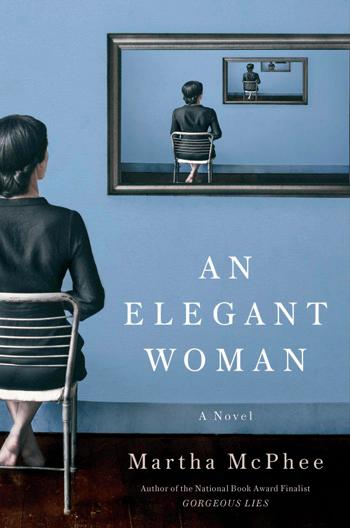
TO CARRY THE KEYS OF THE WORLD’S LIBRARY IN YOUR POCKET
Cloud Cuckoo Land, by Anthony Doerr ’95, H’17

In this newest novel by the Pulitzer Prize-winning author, libraries serve as sanctuaries both physical and spiritual, and it is dedicated to “the librarians then, now, and in the years to come.”
COOPERATE WITH OTHERS FOR COMMON ENDS
On the Other Side of Freedom: The Case for Hope, by DeRay
 Mckesson ’07
Mckesson ’07
A combination memoir and handbook from the civil rights activist, community organizer, and host of Pod Save the People, it is an intimate portrait of the Black Lives Matter movement from the front lines.
Campus Life
PRESIDENTIAL SEARCH COMMITTEE
A search committee has been formed to identify Bowdoin’s sixteenth president. Members were drawn from the board of trustees, faculty, administrative and support staff, student body, and alumni community and announced May 20, 2022, by trustees Sydney Asbury ’03 and Bertrand Garcia-Moreno ’81, P’17, the search committee’s cochairs, and by Robert F. White ’77, P’15, chair of the board of trustees. The presidential search committee will identify and recommend a candidate to succeed President Clayton S. Rose, who announced in April that he will step down from the post in June 2023 at the conclusion of the 2022–2023 academic year. Learn more about the committee members at bowdo.in/president-search.
10 BOWDOIN MAGAZINE SPRING/SUMMER 2022 | CLASSNEWS@BOWDOIN.EDU Forward Campus
Life
Sound Bite
“I wish you love and fulfillment. I wish you wicked problems to solve and a brilliant group of friends with which to solve them. I hope you trust the dark water to fill with abundant light once you take the plunge. I hope you find your own constellation to call home. Thank you for lighting this dark with me.”
—BRIANNA CUNLIFFE ’22, DEALVA STANWOOD ALEXANDER FIRST PRIZE WINNER, FROM HER BACCALAUREATE ADDRESS, “A LUMINOUS ENDEAVOR,” MAY 27, 2022
Campus Life
ARTFUL CONNECTION
In April, the McKeen Center for the Common Good showcased new pieces from Spindleworks, a Brunswick nonprofit art center for adults with disabilities. The McKeen Center’s space in Banister Hall includes a soaring ceiling and plenty of open wall that the center has used advantageously to display Spindleworks art for many years. The artists from Spindleworks also show their work at the organization’s Whatnot Gallery and Store, adjacent to their studio space in downtown Brunswick, as well as in other local and national galleries. When an artist sells a piece, they receive 75 percent of the sale, and 25 percent returns to the program to purchase supplies. “Art livens up every space, but it’s really special to have such a tangible representation of our community reflected [here],” McKeen Center administrative coordinator Avery Friend said. “Often students will purchase pieces at the end of the year, or as they graduate, to keep that community connection with them wherever they go next.”

A Choral Offering
Vineet Shende composes a new piece for Ukraine.
A PERFORMANCE by the Bowdoin Chamber Choir on May 7 featured the premiere of a choral work by Professor of Music Vineet Shende. Shende, a globally acclaimed composer, was inspired to write the piece by the events unfolding in war-torn Ukraine. “While trying to figure out what I, as a composer, could do to help,” said Shende in an email to colleagues, “I came across the devastating poem ‘Missa in tempore belli,’ by the celebrated Ukrainian poet Boris Khersonsky.” Shende was able to get in touch with Khersonsky and received permission to set his words to music. “While I think the majority of the poem would need a full orchestra, choir, and perhaps tenor and soprano soloists to do it justice, I felt the opening section, ‘Kyrie,’ would work best for an SATB [soprano, alto, tenor, bass] a cappella choir.” The result is a short piece (under three minutes), the opening lyrics of which are from the Ukrainian national anthem, translated as “Ukraine has not yet perished.”
To watch a video of the performance, go to bowdo.in/chamber-choir.

BOWDOIN MAGAZINE SPRING/SUMMER 2022 CLASSNEWS@BOWDOIN.EDU 11 PHOTOS: (CHAMBER CHOIR) ANDREW ESTEY; (SPINDLEWORKS) SYMONE MARIE HOLLOWAY ’22
Faculty
The Bowdoin Chamber Choir performing “Missa in tempore belli,” Vineet Shende’s new choral piece for Ukraine.
Spindleworks artist Karen McGann at the McKeen Center show.
Game On
A BEAUTIFUL DAY
CJ Brito-Trinidad ’24 hit a walk-off home run in the ninth inning to lift the Bowdoin baseball team to a 3–2 win over Tufts on a sunny spring day, April 15, at Pickard Field. The Polar Bears never trailed the Jumbos and held a one-run lead from the first inning to the top of the eighth, when Tufts tied the game. Brito-Trinidad was central to the win, going three for four at the plate, with a run scored and a run batted in. The Polar Bears finished 16-19 this spring, with an 8-4 record in NESCAC play to take the NESCAC East division title. A trio of players earned all-conference awards, including Brito-Trinidad (First Team All-NESCAC and NESCAC Rookie of the Year), who finished the season with a .383 average and led Bowdoin in hits (44), runs batted in (30), and slugging percentage (.591), and tied for home runs (5);

Stephen Simoes ’24 (First Team All-NESCAC), who had a team-best .407 batting average and .505 onbase percentage with thirty-three hits in twenty-three games; and Ben
McKenzie ’24 (Second Team AllNESCAC), who, as a leadoff hitter, posted a .315 batting average with a .407 on-base percentage and a team-leading seventeen walks. He also led the team with thirty-three runs and seventeen extra base hits, and tied in home runs (5).
12 BOWDOIN MAGAZINE SPRING/SUMMER 2022 | CLASSNEWS@BOWDOIN.EDU Forward PHOTO: BRIAN BEARD
CJ Brito-Trinidad ’24 (number 5) approaches home plate surrounded by elated teammates after slugging a walk-off home run in the ninth inning to lift the Bowdoin baseball team to a 3–2 win over Tufts on April 15.
ZOE STONOROV ’25
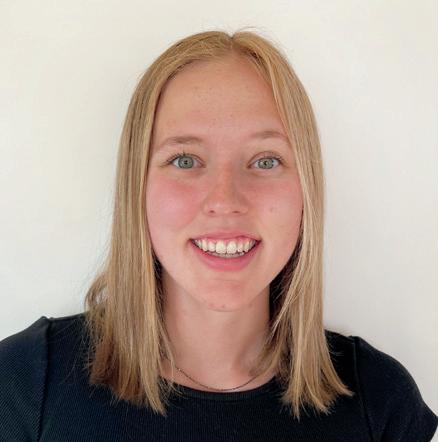
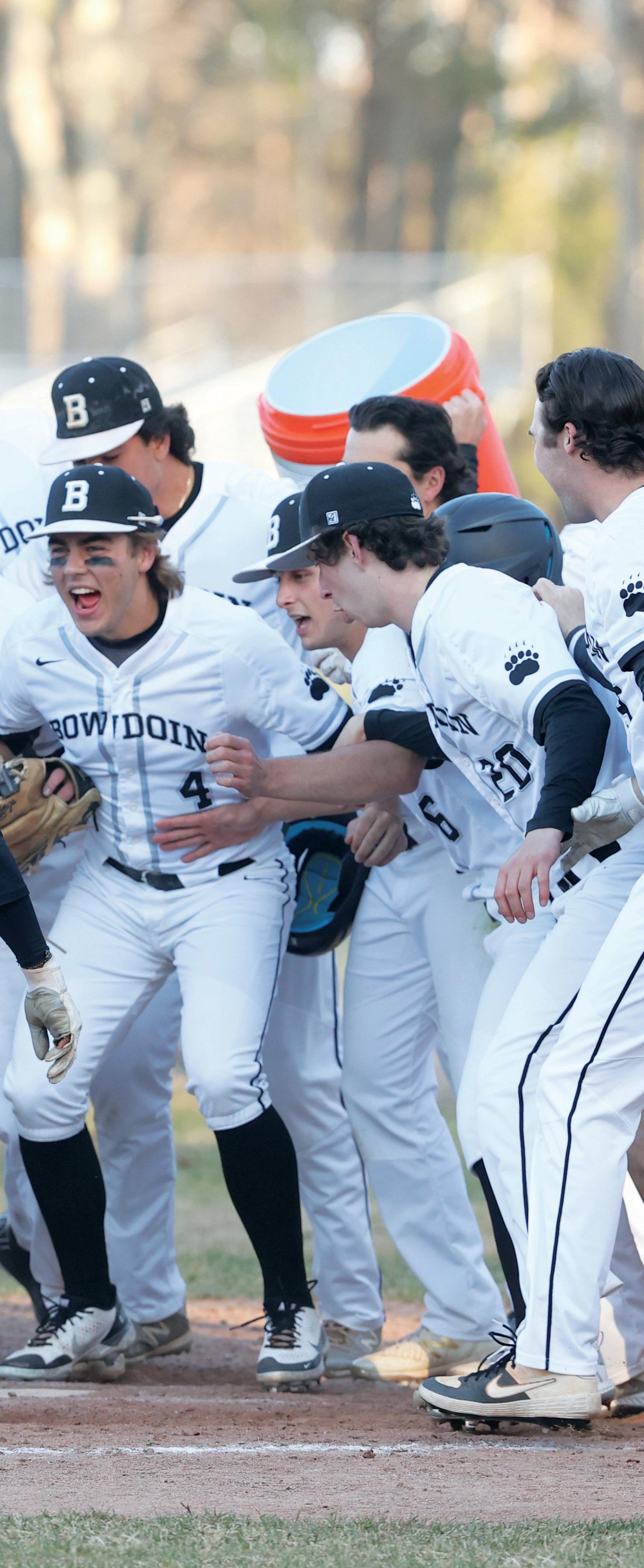
The Alaska native is spending the summer at sea, fishing for salmon in Prince William Sound aboard her parents’ fifty-eight-foot vessel. “I’ve been commercial fishing my whole life. It’s a family business. My sister will be joining us, and we’ll be living and working on the boat, fishing every day from six in the morning to eight at night, if conditions allow. It’s hard work, but very satisfying,” says Stonorov, whose favorite classes are history and earth and oceanographic studies.
AADHYA RAMINENI ’23
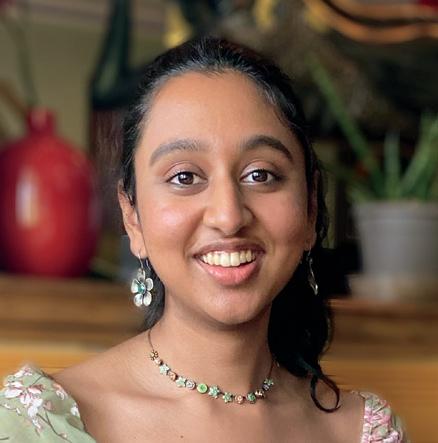
“I have two passions: filmmaking and medicine,” said the biology major and visual arts minor. This summer, Ramineni will employ mostly the right side of her brain, as she’s been commissioned to produce a documentary film about an arts project in downtown Brunswick. Ramineni is profiling an initiative called “Many Stitches,” a mural celebrating the local community to be unveiled on an outside wall of Fort Andross in August.
SHANDIIN LARGO ’23
The Russian and Hispanic studies major heads to Batumi, Georgia, for a summer language immersion program. Largo, who is interested in comparing North American and Russian indigenous cultures, will also be spending the fall semester abroad. “I will be in Bishkek, Kyrgyzstan, further improving my language abilities. This is a fantastic opportunity,” she adds, “not only for academic enrichment, but for new experiences.”
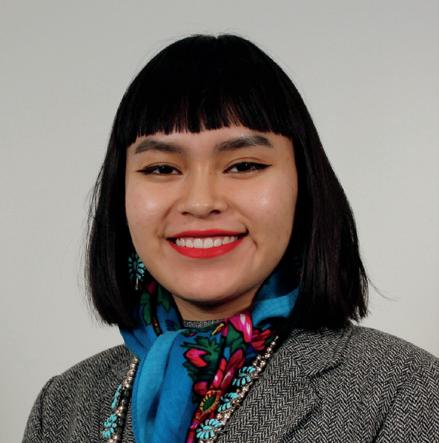
BOWDOIN MAGAZINE SPRING/SUMMER 2022 | CLASSNEWS@BOWDOIN.EDU 13 Student Life
From learning Russian in Georgia to salmon fishing in Alaska to filmmaking here in Brunswick, three Bowdoin students prepare for adventurous summers.
I Never Thought of It That Way: How to Have Fearlessly Curious Conversations in Dangerously Divided Times

MÓNICA GUZMÁN ’05
(BenBella Books, 2022)
Mónica Guzmán ’05, of the national cross-partisan depolarization organization Braver Angels, takes us to the front lines of a crisis that threatens to grind America to a halt— broken conversations among confounded people. She shows us how to overcome fear and uncertainty to do what seems impossible: understand and even learn from people in our lives whose worldview is different from, even opposed to, our own.
Feeling Feelings
The Commissioner: A Sports Mystery

STEPHEN HARDY ’70
(Independently published, 2022)
Equity: How to Design Organizations Where Everyone Thrives
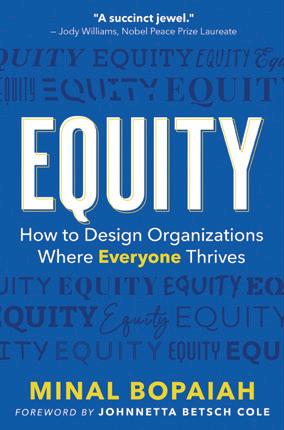
MINAL BOPAIAH ’99
(Berrett-Koehler Publishers, 2021)
Man Up, a three-act musical by Cordelia Zars ’16, explores expectations of masculinity through a touching coming-of-age story about Duncan—a boy forced to choose between staying true to himself or being socially accepted in the rural West. “As Duncan progresses through middle and high school, bullying causes him to question his emotional sensitivity and academic motivation (not seen as masculine traits)—and, ultimately, to reject his own identity in favor of not being an outcast,” says Zars, who majored in music at Bowdoin. But as Duncan comes closer to achieving this ideal of masculinity, he begins to lose his dearest relationships—with his sister and his high school sweetheart. “The central question in Man Up is whether love or social pressure exerts a greater power over our paths through life.”
Zars wrote Man Up in response to the 2017 #MeToo Movement, as an effort to understand the root causes behind violence and discrimination against women. She theorizes that much of gender violence stems from the way that boys are expected to repress their emotions, adopt aggressive behaviors, and turn away help when they most need it. Zars hopes that Man Up can help audiences ponder the idea that gender equality, in large part, begins with emotional liberation for men.
“Our Hemisphere”?

The United States in Latin America, from 1776 to the Twenty-First Century
Britta H. Crandall and RUSSELL C. CRANDALL ’94
(Yale University Press, 2021)
Bonds of War: How Civil War Financial Agents

Sold the World on the Union
DAVID K. THOMSON ’08
(University of North Carolina Press, 2022)
Man Up sold out all of its first eight shows in 2019 in Boulder, Colorado. This past April, it closed its second run as part of Empathy Theatre Project, a nonprofit that Zars founded to “produce original plays and musicals that explore what it means to be American in a time of deep cultural divide.” In its recent eight-show run at the Nomad Playhouse in Boulder, the production— directed in collaboration with Zars’s longtime friend Max Middleton ’16— received standing ovations.
For more, visit empathytheatreproject.org.

14 BOWDOIN MAGAZINE SPRING/SUMMER 2022 | CLASSNEWS@BOWDOIN.EDU
On the Shelf
Forward PHOTO:
COURTESY OF CORDELIA ZARS ’16 On Stage
Man Up, a new musical written by Cordelia Zars ’16 and directed by Max Middleton ’16, follows a boy’s deep sibling bond and his struggle to overcome expectations of masculinity, and explores the redemptive power of love.
Traditions
THE VICTORY MINDSET
Bowdoin celebrated its 217th Commencement on Saturday, May 28. Bachelor of arts degrees were conferred on 450 members of the Class of 2022. As has been the tradition since the College’s first graduation ceremony in 1806, Commencement addresses were delivered by graduating seniors. This year’s speakers, chosen through competition, were Ryan Britt ’22 and Journey Browne ’22 (pictured), who are both Geoffrey Canada scholars. The focus of Browne’s speech, called “The Victory Mindset,” explored the importance of positive thinking and self-respect. For more on this year’s ceremony, visit bowdo.in/commencement.

BOWDOIN MAGAZINE SPRING/SUMMER 2022 | CLASSNEWS@BOWDOIN.EDU 15
PHOTO: MICHELE STAPLETON
Professors and Their Passions

scholars discuss their current research and teaching.
Assistant Professor of Gender, Sexuality, and Women’s Studies Angel Matos studies the intersections between youth literature and media, queer studies, and screen cultures. His current book project explores the queer imagination in texts and media created for teens. “These texts must devise creative ways of articulating complex ideas that are generally deemed taboo to audiences with limited ranges of experience when it comes to notions of gender and sexuality,” said Matos.
Assistant Professor of Chemistry and Biochemistry Kana Takematsu was this year given a CAREER Award by the National Science Foundation. The $458,000 grant will fund her research on how certain molecules, called photoacids and photobases, respond to light. “Potential applications of these molecules cover a broad array of areas, from lithography to the harnessing of solar energy,” explained Takematsu.
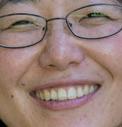

A HEALTH CARE OASIS

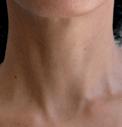


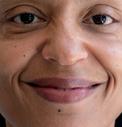

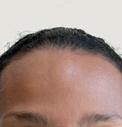












Assistant Professor of Music Marceline Saibou has been teaching a new course this year. Music and Disability Studies explores how disability intersects with music and includes learning about adaptive approaches to musical practice. The class considers issues such as inclusivity and how notions of ability and disability have been shaped within musical contexts. “The course,” said Saibou, “was also enriched by several guests who spoke to their lived experiences as musicians with disabilities.”
“Jean Yarbrough and Paul Franco’s political theory courses highlighted not just the role of government in society, but also the vital function civic institutions play in addressing the needs of a community,” said health administrator Abigail Isaacson Abbott ’08, who credits the two Bowdoin government professors with fostering her interest in community work. Abbott sits on the board of Oasis Free Clinics in Brunswick, a nonprofit that has been offering free medical and dental care to uninsured adults in Midcoast Maine since the mid-nineties. The connection between Bowdoin and Oasis has been strong ever since Dr. Peter McGuire ’62 founded the organization. Many students involve themselves with the clinic as volunteers and with summer fellowships, while three other members of the Bowdoin community, in addition to Abbott, currently serve on the board of directors, including Bowdoin information technology staff member Hannah Rankin, Bowdoin’s Director of Health Professions Advising Seth Ramus, and Dr. John CaCasse ’63, who brings his expertise from a career developing programs to improve health care for underserved populations in Maine and Africa. “The staff and volunteers play an important mentoring role for many students wishing to pursue careers in public health and medicine,” said Ramus.
16 BOWDOIN MAGAZINE SPRING/SUMMER 2022 | CLASSNEWS@BOWDOIN.EDU ILLUSTRATION: MICHAEL AUSTIN Faculty
Forward
Three Bowdoin
Common Good
Athletics
Flying High
The men’s lacrosse team reached unprecedented heights in a record-setting campaign this spring.
UNDER THE DIRECTION of new men’s lacrosse head coach Bill Mason, the Polar Bears established new program marks for consecutive wins (14) and wins in a season (18) and reached the NCAA quarterfinals for the first time in school history. Bowdoin swept the NESCAC’s major honors, capturing Coach of the Year (Mason), Player of the Year (Donal Mullane ’22), and Rookie of the Year (Will Byrne ’24). The Polar Bears also hosted an NCAA tournament regional for the first time on May 14–15, marking the first postseason games in the venerable history of Whittier Field. Six players were recognized with All-American honors for the Polar Bears, whose future looks bright—seven of their top nine scorers, their faceoff specialist, and the squad’s goaltender are all underclassmen.
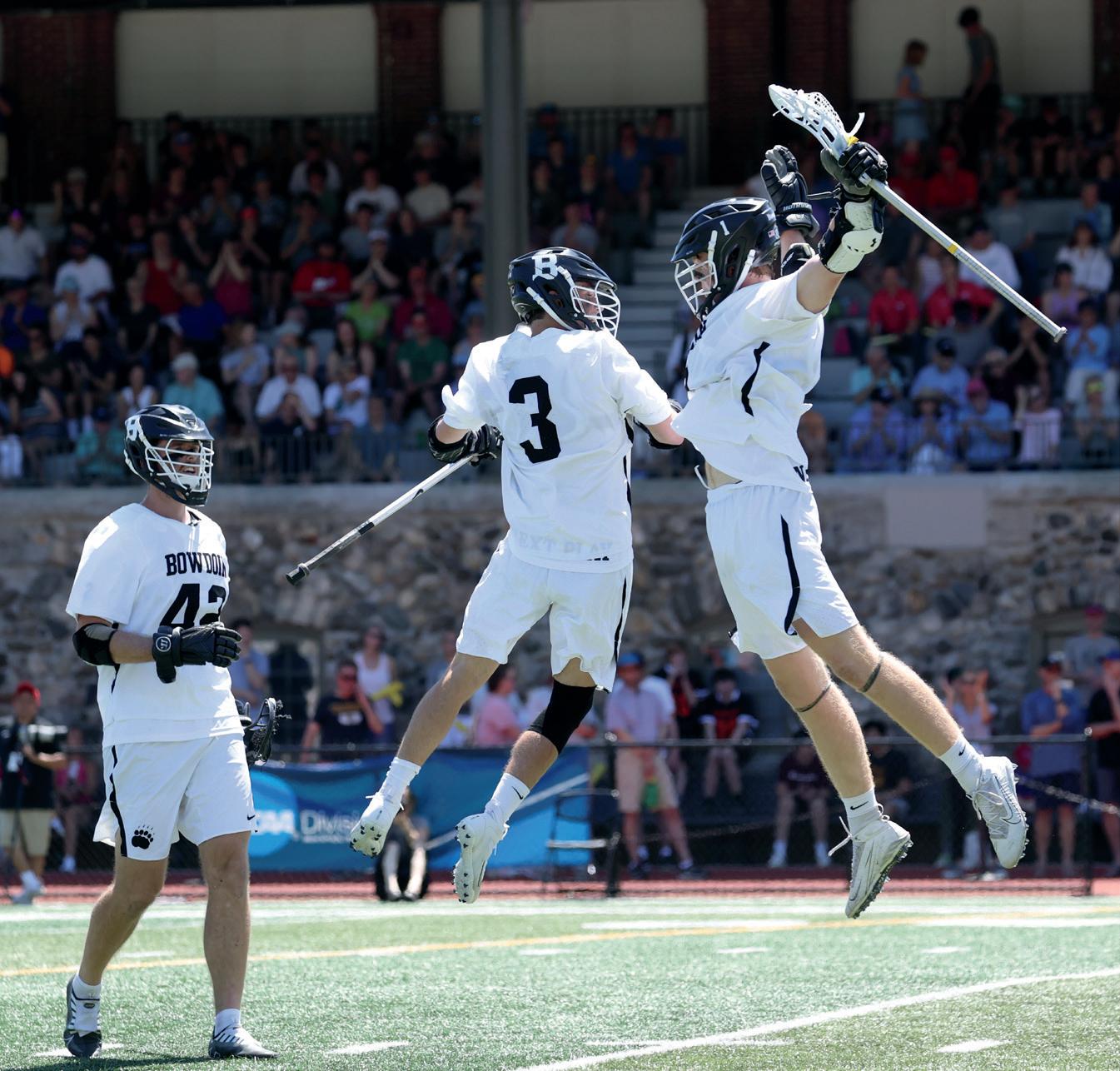
Well Understood
A quartet of musicians accompanied a soprano as she sang the poetry of first-year Bowdoin student Weatherspoon ’25 at a CityMusic Cleveland evening of classical music and contemporary poetry in April. Weatherspoon, who goes by just their last name, joined Bowdoin last summer as a member of THRIVE. The Cleveland native, already a published author before arriving at Bowdoin, has been writing since age twelve. Hearing their words transformed into a libretto, however, was a first. “I’ve never before in my life felt so understood by someone’s interpretation of my work,” Weatherspoon said after joining the musicians on stage for one of their two live performances in Ohio.
CityMusic violinist Miho Hashizume organized the performance “to showcase,” as CityMusic President Ronald Stauss explained, “Weatherspoon’s raw and powerful words that evoke the stress and trauma experienced by many families in Cleveland.”
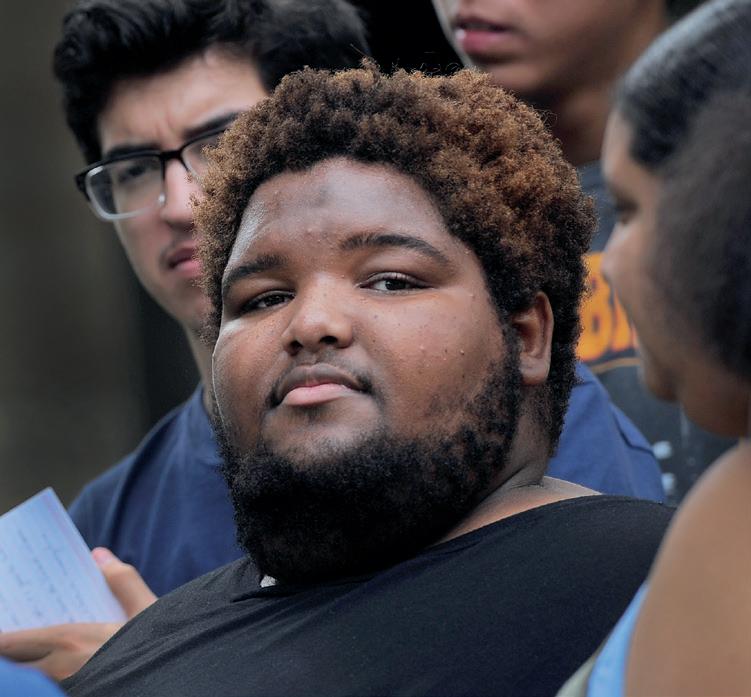
Composers Jessica Meyer and Jasmine Barnes wrote music for several poems in Weatherspoon’s poetry collection, To, Too Many Children: A Collection of Moments, published in 2020 when Weatherspoon was seventeen. “I was immediately struck by how visceral the words are and how powerful the imagery is that comes through quite clearly,” Meyer said in a preperformance talk. “We can’t understand how a seventeen-year-old wrote it.”
To watch the performance, visit bowdo.in/weatherspoon.
BOWDOIN MAGAZINE SPRING/SUMMER 2022 | CLASSNEWS@BOWDOIN.EDU 17 PHOTOS: (LACROSSE) BRIAN BEARD; (WEATHERSPOON) FRED FIELD
Student Life
Weatherspoon ’25
Patrick Fitzgerald (right) catches some celebratory air with teammate Chris Fowler (#3) as Zach Chandler (#42) arrives to join them on May 14 in a 23-8 NCAA tournament win over Colorado College, and the first-ever NCAA game held at Whittier Field.
1:03.34





























Time of a new school record in the 100-meter breaststroke, set by Anna Roberts
1,100






Days between outdoor track and field home meets—three years—until the April 10 meet at Magee-Samuelson Track.
Seconds
































































23' 10.75"
NCAA

By the Numbers
Extraordinary
A full schedule of athletic contests provided one of the greatest indications that campus life returned to a semblance of normal in the 2021–2022 academic year. The impact of games, matches, meets, and cheering crowds on the sidelines and in the stands was keenly felt by the Bowdoin community at large and stretched beyond mere statistics. But Polar Bear athletes, coaches, and teams posted numbers beyond the realm of ordinary during historic winter and spring seasons that rewrote the College record books. Here’s a sampling of those extraordinary facts and figures.
Bowdoin
Bowdoin swimmers and divers competed at the NCAA DIII championship in March.




18 BOWDOIN MAGAZINE SPRING/SUMMER 2022 CLASSNEWS@BOWDOIN.EDU Forward
12
Points scored by Donal Mullane ’22 (six goals, six assists) on April 20 to break the Bowdoin men’s lacrosse record for points in a game.
’23.
for Ajay Olson ’23 to run the 100-meter dash during the Maine State Classic at Bates in April, breaking his own school mark, winning the event, and earning Performer of the Meet honors.
10.64
6
Hits for Ben McKenzie ’24 on April 30, breaking the record for hits in a game, going 6-6 and just a triple shy of hitting for the cycle.
400
Bowdoin career wins for head baseball coach Mike Connolly (March 15, 2002).
career wins for women’s lacrosse head coach Liz Grote (March 19, 2022).
200
13
Distance of the record-breaking long jump by Cheng Xing ’23 on April 18.
4
Nordic skiing championship appearances for Renae Anderson ’21 and Elliot Ketchel ’21, with All-American honors for Anderson.
Seconds for Kianne Benjamin ’24 to run the 60-meter dash, breaking her own school record (7.68) in March. She also set a school record in the 200-meter dash (25.01) on April 18.
7.64
The Show Is On!
Student artists and community judges meet in Lamarche.
ON APRIL 18, Bowdoin’s Lamarche Gallery hosted the opening of the twenty-third Delta Sigma/Delta Upsilon art show. It was especially exciting, according to coordinator Luis Miguel Guerrero ’20, assistant director of student activities, because it was the first show held in person since the start of the COVID-19 pandemic two years ago. The competition is also special to Guerrero because it encourages non-art majors to enter, a fact that urged him to create and enter work himself when he was a student—art that turned out to be deeply meaningful to him. Twenty-eight artists entered a total of ninety pieces into this year’s competition, which attracted a wide range of submissions across a variety of mediums, including video art for the first time. Many submissions centered around a personal narrative from the past, others represented current topics, and each entry included a statement from the artist explaining the inspiration and motivation behind the work.
“There is a wonderful community aspect to the show,” Guerrero said. “It’s supported by the Delta Sigma/Delta Upsilon Activities Fund, an endowed fund that supports campus activities and events—particularly in the arts—that was set up by the members of the former Delta Sigma/Delta Upsilon fraternity. There is even a small grant for students who need funds for supplies.” In addition to alumni involvement through the fund, “community judges from around Maine take part,” explained Guerrero, “with several local artists this year who gave each of the students individual feedback and really encouraged them.” This year’s judges included artist Mary Bourke, photographer Jack Montgomery, and ceramicist and painter Lonie Loffely Ellis. The panel selected pieces by Khalil Kilani ’25, Ereny Morcos ’24, Jilly Sher ’23, Aadhya Ramineni ’23, and Cheng Xing ’23 for this year’s prizes.
Sustainability
SUSTAINABLE BOWDOIN 2042
Building on decades of leadership on environmental stewardship and in the teaching and study of the environment, Bowdoin launched in May “Sustainable Bowdoin 2042,” a clean-energy plan that invests a minimum of $100 million in campus infrastructure between now and 2037 with the goal of utilizing carbon-free clean energy by 2042. The detailed plan for a decarbonized campus within two decades focuses on producing renewable electricity, increasing the efficiency of the College’s building stock, and transitioning to a fossil-fuel-free heating system, while maintaining flexibility to adapt as newer technologies evolve. Key elements of the plan include:
Clean electricity: Based on existing efforts to end reliance on fossil fuels, the College already produces solar power matching 88 percent of its electricity needs. With new contracts for additional electricity sourced from new solar photovoltaic and hydro projects in Maine, 100 percent of campus electrical usage will be supplied by renewable sources by the end of 2023.
Clean heat: With heating during the Maine winter currently responsible for 75 percent of the College’s carbon emissions, Phase I (2022–2037) of the plan creates tighter building envelopes and completely rebuilds the heating infrastructure. Phase II (2038–2042) replaces the gas-fired central heating plant with an alternative energy station.
Other sources: Bowdoin will expand efforts to make the entire campus net-zero, furthering efforts to reduce waste, improve commuting options, and make environmentally responsible procurement choices.

Academic programming: The College will build on existing academic, research, curriculum, and careertraining opportunities to advance student and faculty learning and innovation in the areas of renewable energy, energy efficiency, and sustainability.
Plan progress will be reported on a periodic basis, and both the goals and implementation tactics will be updated over time as progress is made and new technologies emerge. Learn more at bowdoin.edu/climate-action-plan.
BOWDOIN MAGAZINE SPRING/SUMMER 2022 CLASSNEWS@BOWDOIN.EDU 19
PHOTO: CHENG XING ’23
On View
Cheng Xing ’23. “Nature.”
Digital photography, series.
Forward
Academics
Research Grants Rebound

Faculty research grant submissions have returned to pre-pandemic levels. NASA, the National Endowment for the Humanities (NEH), the National Institutes of Health (NIH), and the National Science Foundation (NSF) are among the institutions behind nearly forty active research grants supporting individual labs and research projects led by Bowdoin faculty.
Earlier this year, the NSF awarded Assistant Professor of Chemistry and Biochemistry Kana Takematsu a five-year CAREER grant, which brought the number of Bowdoin faculty whose research is being funded by the NSF to twenty-four. “In addition, we have seven grants funded by the NIH that support basic biomedical research, and three research grants from NASA plus a number of individuals being funded from other sources,” said Cara Martin-Tetreault, director of sponsored research.
Many of these grant recipients are in fields where the material need for equipment and supplies is greater, explained Martin-Tetreault. “Most science scholars have to secure continuous funding support from outside agencies, so applying for grant renewals every two or three years is part of their training as scholars. Also, many Bowdoin humanities scholars receive research support from organizations like the NEH and the Ford Foundation,” she said.
For a complete list of faculty honors and grants since July 1, 2021, visit bowdo.in/grants.
Traditions
WELCOME BACK
Nearly 1,900 alumni from class years ending in two and seven—including three classes celebrating fiftieth reunions— gathered on campus June 2–5 for the first in-person reunion since 2019.
 ILLUSTRATION: HARRY CAMPBELL; PHOTO: TRISTAN SPINSKI
ILLUSTRATION: HARRY CAMPBELL; PHOTO: TRISTAN SPINSKI
20 BOWDOIN MAGAZINE SPRING/SUMMER 2022 | CLASSNEWS@BOWDOIN.EDU
Project ’72
Inside a dusty box, a local man found gold—a treasure trove of photos from the ten days in the summer of 1972 when Whittier Field transformed into Olympus.
“WE WERE IN MY WIFE’S FAMILY HOME in Bath doing some tidying,” recalls Todd Coffin, “when I found an old box tucked away on a bookshelf. Inside was this dusty stack of about twenty blackand-white photos of athletes, mostly runners.” The athletes and the surroundings were familiar to Coffin, a Colby graduate and former distance runner. “I realized these prints might be a big deal when I came across a signed photo of legendary long-distance runner Steve Prefontaine and the setting was clearly the Bowdoin campus.” There were many other familiar faces too: gold medal winners like marathoner Frank Shorter H’16, middle-distance specialist Dave Wottle, sprinter Eddie Hart, and the legendary decathlete Bruce (now Caitlyn) Jenner.
The photos had been given to Coffin’s father-in-law, the late Bud Caverly ’56. No one in Coffin’s extended family knew where the photos—which were clearly the work of a professional—came from or who took them, but everyone was familiar with the occasion. In July 1972, most of the US men’s Olympic track team held a training camp on the Bowdoin campus just before heading to the Munich Olympics. Three Bowdoin community members were instrumental in making it happen. “Bowdoin’s head physician, Dr. Dan Hanley ’39, was the US Olympic Team’s chief doctor at the time,” explained Coffin. “Bowdoin head track coach Frank Sabasteanski ’41 coached the US national team in the late ’60s,” and Frank’s wife, Barbara, had been the US Olympic team nurse in three previous Games.
Coffin knew the images should be seen by others, and he began research to find additional photos of the historic visit. Thanks to Steve Podgajny, former director of the Portland Public

Library (and a notable distance runner himself), Coffin gained access to dozens of photos, unseen for decades, from the Portland Press Herald archives, housed at the Portland library. This summer, Coffin hopes to publish his retrospective, Olympians in Vacationland, to coincide with the fiftieth anniversary of the Munich Olympics. The Munich Games have special meaning because of the infamous Palestinian terrorist attack that killed eleven Israeli athletes. The Games continued in spite of the terror and in deference to the sacrifice of the athletes. “We have to spread the word by our performance that barbarism only makes Olympians stronger,” said Shorter, who went on to win gold in the men’s marathon, one of thirty-three awarded to the US Team in the summer of 1972.
For more, visit bowdoin.edu/news.
Above:
The autographed photo of Steve Prefontaine training on Magee track in the summer of 1972 that Todd Coffin found in a box at his in-laws’ home in Bath. It initiated Coffin’s Olympians in Vacationland, a photographic retrospective of the men’s US Olympic Track Team training camp at Bowdoin in the weeks before the Munich Olympics.

BOWDOIN MAGAZINE SPRING/SUMMER 2022 | CLASSNEWS@BOWDOIN.EDU 21
PHOTO: COURTESY OF TODD COFFIN
Archives
Book Club
At the beginning of the pandemic, Emily Cohen ’20 and a group of classmates started a virtual book club simply to stay in touch. In the end, they were surprised where Book Club took them.
ALMOST EXACTLY TWO YEARS AGO, I graduated from college. I sat in my childhood home and watched my name scroll past with my classmates’, the cast of the cursed Class of 2020. A friend of mine glibly compared the ceremony—the list of our names and a montage of pictures—to an “in memoriam” segment of an awards show. It’s not that I’m still bitter about the virtual commencement, or even about just getting my diploma in the mail. Looking back on it now, two years into the pandemic that changed everything, it was the best Bowdoin could do for a while. But we didn’t know that yet.
It felt silly and surreal to end my time in college in such an anticlimactic way. I Zoomed with my friends afterward and we commiserated about it, but also reminisced and gossiped and laughed for hours, as we would have if we’d graduated in person. We did a lot of that back then: simulating face-to-face gatherings and interactions to stay in touch and, more fundamentally, to give us something to do.
Like many people, one way we did this was through the formation of a virtual book club. Ours had its first meeting in August 2020; we read The Outsiders by S. E. Hinton, taking inspiration from the bookshelves filled with paperbacks we hadn’t touched since middle school. At first there were only a handful of us, but after the first successful meeting we extended the invitation to about a dozen of our classmates. We weren’t all friends, necessarily, though we all had Bowdoin in common as well as a desire to replicate some sense of community that we’d been missing those last few months.
Not that I had been part of a book club before then. I’d have been hard-pressed, in fact, to name the last book I had read for fun, meaning not for school. It had probably been something I read while on vacation, liberated from the papers and tests and Blackboard discussion posts that had for four years dictated
what, when, why, and how much I read. More than that, I’m a nerd who enjoys school and I’d insisted I was reading “for fun.”
But then I picked up The Outsiders again and was transported to the gang-riddled streets of a 1960s Tulsa, Oklahoma, evoked so profoundly by its teenage author. Next, we went to colonial West Africa in Yaa Gyasi’s sprawling Homegoing, following the story to antebellum Baltimore to Reconstruction Birmingham to revolutionary and independent Ghana and back again to modern day. After that, we went to a dozen distinct scientifically advanced worlds in Exhalation: Stories by the inimitable Ted Chiang. It wasn’t always fun, but I was reminded, for the first time in a while, of the unique ability of literature to engross and move, emotionally and seemingly physically, too.
As a collective, Book Club was keenly aware of distance and location. Our members at one point spanned ten time zones, from Alaska to Kenya. I was in Austria, teaching English somewhere in the space between lockdowns with Microsoft Teams meetings and masked classrooms with the windows open. Like many people during that first dark pandemic winter, I was lonely much of the time, and I was probably a bit depressed too. I filled my time by cooking, going for walks. I watched all of The Good Place, The O.C., and New Girl—that one twice.
And, thanks to Book Club, I read a lot more than I had in years. Finding times to meet that worked for all of us was no small feat, and we didn’t always succeed. But when we did, our discussions flourished, taking up space, sometimes upwards of two hours, because of our enthusiasm, and because what else did we have to do?
Those Zoom calls connected me not only to my friends but to my home as well. I have never felt more American than I do in Austria, in a job where I’m often asked to share my perspective as an American on some uniquely American issues
and current events, like mass shootings and the January 6th insurrection. But I always felt like I was talking about these things with people who didn’t get it, who could never get it, not fully.
Intentionally or not, we talked a lot about America in Book Club. In our discussion after reading Tayari Jones’s An American Marriage, we disagreed about loyalty in the face of grave injustice. We read Jhumpa Lahiri’s The Namesake and wondered how the experiences of first- and second-generation Americans have changed over time, with three of our members being secondgeneration themselves. We debated the merits of J. D. Vance’s Hillbilly Elegy. Maybe I was seeking to understand my home better now that I was asked to explain it. Maybe I was just homesick.
I returned to the US over the summer, in part so I could attend the celebration for the Class of 2020 that Bowdoin held for us in August. In Book Club we talked excitedly about seeing each other in person; it would be the first time in over a year for some of us. The weekend was busy and overwhelming and fun—and sufficient. By the end I felt ready to move on from Bowdoin. I hadn’t realized before that I wasn’t.
Book Club fizzled out, our group chat growing more and more dormant as people got busier, started new jobs, and moved to new cities. Back in Austria, I moved into a new apartment and started work again. In a more open phase of the pandemic, I had less free time, less time to read. It was sad, but not surprising. Book Club couldn’t last forever; this we knew from the outset. Indeed, in the first email inviting people to join our virtual meetings we called the club the “Fall 2020 Book Club.” Some things last longer than we expect them to.
But, I missed Book Club. More than the incentive to read again, more than the quasiintellectual stimulation, I missed my friends. And more than the ability to access dozens of places beyond my own, occasionally bleak, one, I missed my home. It was then that I realized that my friends and my home were one and the same.
A few weeks ago I opened up the Book Club group chat for the first time in months and started to type. “Hey, friends, it’s been a minute...”
Emily Cohen ’20 is a writer and English teacher in Vienna, Austria.
22 BOWDOIN MAGAZINE SPRING/SUMMER 2022 | CLASSNEWS@BOWDOIN.EDU Column

BOWDOIN MAGAZINE SPRING/SUMMER 2022 CLASSNEWS@BOWDOIN.EDU 23 ILLUSTRATION: JAY VOLLMAR
BY TOM PORTER • PHOTOGRAPHS BY ALEX CORN E L L DU HOUX ’06
HOOK, LINE, AND SINKER
Pickard Theater returned to life this spring with a vibrant and beautiful musical based on the myth of a water creature who assumes human form. Adapting Ondine for 2022, director of the production Davis Robinson says, meant “centering the narrative on the true power of the natural world and the failures of the civilized world to listen to its warnings.” Despite its serious theme, its sets and staging were dazzling and wildly creative, and its lyrics and dialogue are full of laughs, heart, and permission to fall “helplessly, hopefully” in love.


CAST
Lyle Altschul ’23
Jacqueline Boben ’22
Journey Browne ’22
Louise Cummins ’23
Henry Jodka ’24
Jonathan Li ’25
Emma Paterson-Dennis ’24
Angelica Peña ’22
William Rackear ’22
Molly Richardson ’25
Wilder Short ’22
Cloe Tarlton ’23
Vincent Tran ’25
Joosep Võrno ’22
Lauren Waters ’22
CREW
Ben Allen ’23, fly rail
Alison Ambrosio ’22, wardrobe crew
Hailey Aronson ’22, wardrobe crew
Lexi Ashraf ’24, assistant stage manager
Bryant Blackburn ’22, sound board operator
Lorenzo Hess ’23, light board operator
Grace Kellar-Long ’21, follow spot
Chun Ko ’25, assistant stage manager
Emmy Lawler ’22, stage manager
Lily Smith ’23, follow spot
Lou Sydel ’22, choreographer
Gianna Turk ’24, assistant stage manager and video operator
Chris Zhang ’25, assistant director
Opening spread:
In the opening scene of the musical, the company performs “Lake Frolic,” an underwater dance set to a jazz waltz that portrays the idyllic—but also comic and tragic—life of the naiads (nymphs) and other creatures of the lake.
Opposite page:
The company sings “Crème de la Crème”— a song about the tendency to turn willfully away from hard truth and a reference to the blind eye humans turn to climate change— at the end of Act 1.
AFTER MORE THAN FOUR YEARS in the dark, Pickard Theater came back to life as a new musical hit the stage. Bowdoin’s department of theater and dance taps a wealth of in-house talent for Hook, Line, and Sinker. Inspired by a European folk tale about a water nymph who falls in love with a human, the piece resonates on many levels, says director and theater professor Davis Robinson.
Hook, Line, and Sinker is a musical adaptation of the French play Ondine, written in 1938 by Jean Giraudoux, which in turn was based on earlier myths about a knight called Hans who falls for a water nymph called Ondine.
The play was translated and turned into a musical by Bowdoin staff member Delmar Small, who, as well as being concert, budget, and equipment manager for the music department, is a talented musician, writer, and theater producer.
Small says the project was born out of a discussion he had with Robinson in November 2019, on the closing night of the Cole Porter musical revue. “I said to Davis I would really like to write a musical, and if I did, would he direct it? He was really keen on the idea and suggested I base it on Ondine.”
The result was an energetic two-hour show with a cast of fifteen students who filled a variety of roles. As well as acting, they were also singing and dancing, playing music, and dealing with costumes and puppets. Three years ago, Small was composer-in-residence at the Eugene O’Neill Theater Center in Connecticut and worked with all sorts of puppets.
“It was so much fun,” he adds, “that I immediately thought of puppets when I started working on this show, which features shadow puppets, hand puppets, stick puppets, and marionettes.”
To help with that side of the production, adjunct theater lecturer and puppet designer Libby Marcus came on board. The impressive design team also included Lily Prentice ’10, who is responsible for the costumes, and set designer Judy Gailen. “Our highly professional designers have really gone all out to create a wonderful imaginary world and bring this parable to life,” says Small.
When it came to composing and orchestrating the score, Small went for a more classical set-up, eschewing the drum kit and double bass typically found in a musical theater pit orchestra.
“The performance is quite ballet-like, with some dance routines included, so I went for more of a chamber group sound, with flute, horn, violin, cello, piano, harp, and miscellaneous percussion. This is my second musical, and it’s by far the largest production I’ve been involved with.”
Hook, Line, and Sinker has, quite literally, many moving parts, said Robinson, and is the biggest show to hit the Pickard stage since The Threepenny Opera in 2017. “This was originally supposed to be performed in either the fall of 2020 or the spring of 2021, but, of course, the pandemic happened, and we lost a couple of years!”
The legend of the water nymph, known as the “selkie” in Celtic and Norse mythology, can also be found in Greek and Native American myths, says Robinson, as well as more modern iterations on the stage and the big screen.
“There was recently a German expressionist movie, called Undine, that was based on the legend. A few years earlier there was a film with Colin Farrell, also called Ondine, about an Irish fisherman who falls in love with a selkie. Then, of course, there was Splash.” Robinson is referring to Ron Howard’s 1984 romantic comedy, starring Daryl Hannah as a love-struck mermaid and (very) loosely based on the legend of the selkie. The enduring appeal of the tale, explains Robinson, is the contrast between the purity and innocence of the water nymph and the cynicism and immorality of the human world.
“The relationship between Hans and Ondine is doomed from the start,” he says. “On one level, the story is a parable about the human soul. What does it mean to be human? Can nonhumans have a soul?”
This production explores other themes too, he explains, notably the way mankind abuses nature. “It’s a perfect parallel for where we are now with climate change. The earth is getting hotter and drier… and the worst thing is that we know it’s happening but seem unable to stop it.”
Despite such weighty topics, says Robinson, delightful moments of comedy shine through the play, such as a TV game-show scene featuring shadow puppets, an actor in a horse costume, and giant dancing lily pads.
To watch the production, visit bowdo.in/hook.
26 BOWDOIN MAGAZINE SPRING/SUMMER 2022 | CLASSNEWS@BOWDOIN.EDU

BOWDOIN MAGAZINE SPRING/SUMMER 2022 | CLASSNEWS@BOWDOIN.EDU 27
—“CRÈME DE LA CRÈME,” ACT 1, SCENE 7
Thank goodness we’re us and not them!”
“We will turn, we will turn, we will turn up our noses.

28 BOWDOIN MAGAZINE SPRING/SUMMER 2022 | CLASSNEWS@BOWDOIN.EDU
is a poorly written play that suffers from a lack of direction. ”
—“THE CHASE,” ACT 1, SCENE 4
“When you are as old as I am today, you may see that Life
Opposite page:
The Old One (Jacqueline Boben ’22), seated on the right, prepares to warn Ondine about what it will mean for her to marry a human, saying that if Hans betrays her, he will die.
Left:
Hans’s horse (Joosep Võrno ’22) singing “Curse of the Wittensteins”: “A curse is a curse, and who’s the worse? Until I’m there pulling the hearse, the hearse. What’s worse, you ask, or more perverse? It’s the curse of higher ed.”

Below:
Walter the poet (striped pants; Vincent Tran ’25) appears before the judges in the trial of Ondine, who is accused of having an affair with him. The judges are played by Emma Paterson-Dennis ’24, Journey Browne ’22, and Lyle Altschul ’23.


BOWDOIN MAGAZINE SPRING/SUMMER 2022 | CLASSNEWS@BOWDOIN.EDU 29
Above:
Henry Jodka ’24 plays Theseus, the mythic warrior, here taking part in an ecologically themed TV game show called “Best That Quest,” in which he gets to slay the centaur after spinning the “wheel of misfortune.”
Right:
Musicians for the show included Kayla Stuhlmann ’22 (horn); Joshua Lin ’22 (harp); Ari Geisler ’23 (cello); Jimmy Song ’25 (violin); and Jeff Christmas, faculty (piano). Not shown here: K Zhan ’25 (percussion); Anya Workman ’25 (flute); and Charlie McLarnon ’24 (clarinet).

Opposite page: Curtain call. The company performs the show’s theme song, “Hook, Line, and Sinker.”

30 BOWDOIN MAGAZINE SPRING/SUMMER 2022 | CLASSNEWS@BOWDOIN.EDU

BOWDOIN MAGAZINE SPRING/SUMMER 2022 | CLASSNEWS@BOWDOIN.EDU 31
Hook, line, and sinker—that’s the only way to fall inlove. ”
“Helplessly, hopelessly, head over heels in love.
—“HOOK, LINE, AND SINKER,” CURTAIN CALL
2022 HONORARY DEGREE RECIPIENTS
KATHERINE BRADFORD
RAQUEL JARAMILLO
LAURIE GAGNON LACHANCE
JANET LANGHART-COHEN
JOAN BENOIT SAMUELSON
FOR THE SAKE OF HONOR
(Honoris Causa)
On May 28, for the first time in 217 Commencement Ceremonies, the College presented all of this year’s honorary degrees to women as part of its celebration of fifty years of women at the school. Accomplished across all different fields, these five women inspire not only with their achievements but also with their graciousness, generosity of spirit, and grit. Accepting challenge after challenge, each called upon in her own way to find courage and determination, they all remained, as writer Kenny Moore once put it, “unharmed by victory.”
BY TASHA GRAFF ’07
ILLUSTRATIONS BY LYNE LUCIEN ’13

KATHERINE BRADFORD
KATHERINE BRADFORD’S PAINTINGS are full of color and emotion. Androgynous and often faceless subjects swim, dive, dance, and embrace; they float in bodies of water and in outer space. Her singular style is as bold as it is unassuming, and her paintings are instantly recognizable.
Over the course of six decades, Bradford created a body of work that transformed her from a new painter who first began making art after moving to Brunswick, Maine, to one of the state’s most iconic and beloved contemporary artists. Her paintings are shown in galleries and museums across the world, including the Metropolitan Museum of Art in New York and the Institute for Contemporary Art in Boston. Approximately forty of her paintings will be on display at the Portland Museum of Art throughout the summer in the show Flying Woman: The Paintings of Katherine Bradford

Bradford’s grandfather Jacques André Fouilhoux was a famous architect, a profession her brother also took up, but Bradford’s mother encouraged her daughter to follow a more traditional path: “I think she thought being an artist meant that you would lead a desolate life, and she wanted other things for me, like all mothers,” said Bradford.
Born in 1942 in New York City, Bradford grew up in Connecticut and left home in 1960 to attend Bryn Mawr, where she earned a BA in 1964. She married Peter Bradford soon thereafter and gave birth to twins in 1969. Her life became the traditional one her mother wanted for her: an educated wife and full-time mother. Something was missing, though Bradford had not quite figured out what. It wasn’t until the early seventies in Maine that she discovered a community of artists, and her world was upended.
34 BOWDOIN MAGAZINE SPRING/SUMMER 2022 | CLASSNEWS@BOWDOIN.EDU
Katherine Bradford upended her world to live and work as the artist she wanted to be, making paintings filled with feeling.
The artists she met in Maine shaped her future: “The way they lived their lives and questioned the system appealed to me so much. It finally clicked with me that being an artist was a way of going through life, a whole worldview. I could relate to that.” By 1975, she had cofounded the Union of Maine Visual Artists and began reviewing art for The Maine Times
Even so, life as an artist did not come easily. She broke from conventions of the time to pursue painting. “By the time I admitted to myself that I wanted to be not just an artist, but a good artist, nothing was in place. I was living in Maine, we had a woodstove and an organic garden, and it took me a long time to turn my life around and live as an artist—including getting divorced. The big thing was that the grandmothers wanted me to be there raising the kids.”
Bradford moved to New York with her children despite her family’s disapproval. Asked what made her “take the leap” to become an artist, Bradford replied, “It wasn’t a leap. It was one step after another.” In an interview with her son Arthur years later, Bradford explains how the move impacted the twins: “When we moved to New York, you both were distraught, but in time each of you in your own way thanked me for introducing you to city life. I needed New York. The language of painting is spoken so fluently and so beautifully there.”
Bradford began generating a tremendous amount of work. In 1987, she graduated from SUNY–Purchase with an MFA. She began to exhibit in galleries and, slowly but surely, began to attract attention and recognition in the art world.
In the beginning, Bradford had thought of herself as a maker of marks, an abstract painter. But she began to see forms in her work even as she did so. “Because the surface was made using many thin layers of paint,” she said, “small shapes and glints of light would appear, sometimes
suggesting something underwater.” After a while, she realized maybe she wasn’t an abstract painter after all, that the fields of color could lead to landscapes and expanses of ocean.
In an interview with The Brooklyn Rail in 2007, Bradford said, “If you want to ask me pointblank why I stopped being an abstract painter and reintroduced images into my work, I can tell you. It was because I wanted more emotion and I wanted to tell stories.” In 2010, Bradford received a Guggenheim Fellowship, and a year later she received a grant from the Joan Mitchell Foundation. She has also received awards from the American Academy of Arts and Letters, grants from the Pollock-Krasner Foundation, and the Rappaport Prize.
Bradford describes finding her voice in a 2017 interview with New American Paintings: “I think [we artists are] trying to speak a language, a visual language, and it takes a long time to develop a very personal vocabulary. It certainly took me years and years to find my own voice. And I wouldn’t say it has anything to do with age; it had to do with sticking to it, and doing it a lot, like an athlete.”
She works on paintings in her studio, where they are surrounded by all her other paintings, and she has said that “the characters I work with, like divers and soaring superheroes, travel to neighboring paintings in my mind,” creating worlds where swimmers float along in outer space or figures in capes soar above the sea. Admitting that it’s expensive to have so many unfinished paintings around, she says, “Sometimes I line them up here and take a brush, like a doctor visiting a ward, and I try to save the ones that are dying.”
But none ever seem to be dying. Artist Anna Kunz describes Bradford’s work as being “akin to poetry in its attempt to turn fleeting emotions into something concrete and thinkable,”
and said, “More than anything, I like Bradford’s paintings because they are so unequivocally what they are: unpretentious and joyful, at times discomfiting, and at times just plain funny.”
Bradford works to create community with her audience.“I have two paintings which are somewhat about identity,” Bradford said. “They’re figures with choices of different heads. I’m exploring who we are, how we fit in, how we fit in together visually, how we all stand next to each other, and there are quite a lot of options for how to look and be with one another.”
Riders of the New York City subway can view Bradford’s work in an unlikely spot: the L train station at the intersection of First Avenue and East 14th Street. Commissioned by the MTA and unveiled in September 2021, the permanent installation consists of five glass mosaic murals depicting her whimsical characters. There are superheroes, a man in a ball gown in a garden of white flowers, and figures dancing across an expanse of blue. Two at the entrances can be glimpsed from the street. Bradford said at their unveiling, “Once someone steps into the subway area, we become travelers, and my hope is that these artworks will transport you to another place.”
Her most recent exhibition, Mother Paintings which collects works that Bradford created during the pandemic, when she said she was thinking of comfort and caregiving—has been called “a heartfelt meditation on raising other beings—children, paintings—and being raised oneself,” by critic Jason Patrick Brooks, who went on to say: “Bradford also grapples with her own legacy and with the legacies of her predecessors, be they relatives or fellow artists, asking vital questions about what it means to be remembered and to leave a mark.”
In her eighties, Bradford is still painting, still giving talks, still hosting studio visits. She and her spouse, Jane O’Wyatt, whom she met in 1990, split their time between New York and their home in Maine. “Now I’m surrounded by an entire community of artists, and not too many of them had to fight as hard as I did to become an artist. And in a way, I think it’s why I’ve stuck with it. When I wake up in the morning, I’m not going to fool around, I’m going to get to the studio.”
BOWDOIN MAGAZINE SPRING/SUMMER 2022 | CLASSNEWS@BOWDOIN.EDU 35
“I’m exploring who we are, how we fit in.”
RAQUEL JARAMILLO
RAQUEL JARAMILLO P’18 is a writer, illustrator, and graphic designer who writes under the pen name R. J. Palacio. Her parents emigrated from Colombia to New York City, and Jaramillo was born in 1963 in Queens, where her parents raised her in a home surrounded by books.
Her mother, formerly part of a literary circle in Baranquilla, Colombia, loved Latin American literature, but was particularly passionate about Oscar Wilde and William Faulkner, and the bedtime stories she read to Jaramillo were the short stories of Oscar Wilde and de SaintExupéry’s The Little Prince. Her father preferred historical tomes: Marcus Aurelius, Pascal, and Will and Ariel Durant’s eleven-volume Story of Civilization. The whole family loved the epics so popular in the 1970s—Clavell’s Shogun, Michener’s Centennial, and the like. Growing up in that environment, Jaramillo was destined to be a reader, and her mother always told her she would be a writer.
Jaramillo went to elementary school in Flushing, at P.S. 22, and graduated from the Manhattan High School of Art and Design in 1981. She earned her BFA in illustration at the Parsons School of Design in 1985 and spent her junior year studying at the American University of Paris in France. “I’d always sort of toggled back and forth when I was in my late teens and early twenties with ‘Do I want to make a living as a writer, or do I want to make a living as an artist?’” she said. “Ultimately, I chose to make a living as a graphic designer because I’m totally fine illustrating someone else’s stories, but I didn’t want to ever have to be told what to write.”
After graduating from Parsons, Jaramillo began her career as a freelance illustrator,
publishing her artwork in The New York Times Book Review and The Village Voice. She then took a job as an art assistant at Scribner’s, which marked the beginning of a twenty-five-year career in publishing. She left Scribner’s for Henry Holt, where in her seventeen years as creative director she was responsible for an estimated one thousand books, including the works of Paul Auster, Salman Rushdie, Louise Erdrich, Hilary Mantel, and many others, before moving to the other side of the table to become editorial director and creative director of children’s publishing at Workman Publishing. Along the way, she illustrated classics like Peter Pan and The Night Before Christmas and created board books like Dream, Baby, Dream.
While the world wouldn’t know Jaramillo as a writer until her debut middle-grade novel, Wonder, was published (as R. J. Palacio—Palacio being her mother’s maiden name) when she was forty-eight, she always wrote for herself. When she was eight and in the third grade, her school newspaper published her poem “The Winged Steed.” “I actually have been writing my whole adult life—bits and pieces of novels, lots of stories, and mostly ideas for books, screenplays,” said Palacio. “But I never carved out the time I needed to have to follow through on these ideas. I’m so glad that I had all those years to quietly hone the craft.”
The idea for Wonder, the story of ten-year-old Auggie Pullman, a boy with a severe facial difference who attends school with other children for the first time as a fifth grader after being homeschooled by his mom, came to Jaramillo after an incident with her own children. “I was in front of an ice cream store with my two sons, and my younger son, who was only three at the time, saw a little girl that had a very significant craniofacial difference. He got a little scared and he started to cry.” Jaramillo whisked her boys away quickly so as not to upset the girl and her mother, but she could not stop thinking about what the girl’s experience with the world
must be and what Jaramillo might have done differently—and compassionately—as a parent. She decided to write.
Jaramillo’s only time to do that was in the middle of the night, when her family was asleep. She began to write from midnight until three in the morning and, after a year and a half, she had completed a draft of the novel that would change her life. Wonder not only became an instant bestseller, it also spawned an international Choose Kind movement, with school programs, community reads, and other events that nurture respect, compassion, and civility.
“I really had just set out to write a little book—a quiet, simple book,” said Jaramillo. “There are no vampires or wizards. It’s really just a book about kindness: the impact of kindness, the choice to be kind.”
Made into a movie starring Julia Roberts and Owen Wilson in 2017, Wonder has been translated into fifty-five languages and has spent more than nine years on The New York Times bestseller list, with 199 weeks in the number-one spot. Wonder and its companion books, Auggie and Me, We’re All Wonders, 365 Days of Wonder, and White Bird, have together sold more than 13 million copies. White Bird, which features the character Julian from Wonder, is set during World War II, and is about Julian’s grandmother—then a young Jewish girl hidden by a classmate and his parents in Nazi-occupied France. A film version starring Gillian Anderson and Helen Mirren is set to be released this fall.
Jaramillo describes the reaction to Wonder as “well beyond my wildest dreams—and anyone who knows me knows of my capacity to dream big,” but says that it’s the reaction of readers that moves her most. It’s “the librarians who have taken Auggie Pullman into their hearts and want to share his story with their students… the teachers who share their stories about the intensity of their classroom discussions after their daily Wonder read-aloud…but most of all, it’s the kids who have said or written to me,
36 BOWDOIN MAGAZINE SPRING/SUMMER 2022 | CLASSNEWS@BOWDOIN.EDU
Illustrator and best-selling author
Raquel Jaramillo—R. J. Palacio to her readers—wrote a “little, quiet book” that launched a Choose Kind movement.
tweeted, or even blogged that reading Wonder made them want to be kinder people. Kids wanting to be kinder people?” she said. “Can it get better than that?”
Jaramillo believes in the importance of tackling difficult topics in children’s literature. “Children understand and perceive everything,” Jaramillo has said. She wants to use her books as a way to spark reflection and conversation about serious topics and about things happening in the world, whether directly to children or to children and adults they see in the news. “In my mind, the willful ignorance of others is the one thing writers and artists can actually address. Writers and artists can make looking away from hard truths impossible.”
Her latest novel, Pony (2021), is her first book with characters set outside of the Wonder universe, and Jaramillo describes it as a “big departure.” Set in America of the mid-1800s, Pony is the story of Silas, a twelve-year-old boy on a journey to rescue his father, with a ghost as his companion and a mysterious pony as his guide. The action is gripping, even scary at times, and the book tackles the very big subjects of love and grief. “As a parent,” Jaramillo said in an interview, “I take my job as an author for children really seriously because I know that they can’t read everything their kids read and they don’t want their kids to be traumatized. But challenged is a different thing. A little bit of pushing them to think in terms of the universe and mysteries and accepting big, life things— that’s okay.”
More than a thousand classrooms are “certified kind” through the Certified Kind Classroom Challenge, and Jaramillo has visited dozens and dozens of them, giving talks and meeting with students and teachers. “I am so impressed by the kids I meet in schools. I’m blown away by their beautiful desire to do good,” Jaramillo said. “I know that I’m only seeing one side of them during these school visits, which are usually arranged after the kids have read Wonder, so they’re perhaps more primed to act a certain way.” But, she says, “I’ve always thought that most kids are truly noble to their core and that, when given a chance—and a push—nobility can manifest itself in the most surprising times and ways.”

BOWDOIN MAGAZINE SPRING/SUMMER 2022 CLASSNEWS@BOWDOIN.EDU 37
“Writers and artists can make looking away from hard truths impossible.”
LAURIE GAGNON LACHANCE

A leading economist for decades, Laurie Lachance caps a career serving the home state she loves with a Maine college presidency.
LAURIE GAGNON LACHANCE ’83, P’13 grew up in rural Maine in the town of Dover-Foxcroft, which has a population of about 4,000 people and is bisected by the Piscataquis River.
Dover-Foxcroft might seem like an unlikely starting point to produce a future state economist, the first woman to hold that position, but maybe there was something in the water. Just over one hundred years before Lachance graduated from high school, a local named Mary Mitchell Birchall (1840–1898) left Dover to become the first woman to earn a bachelor’s degree in New England, graduating from Bates in 1869.
Lachance too has gone on to make history, becoming the first woman to hold not only the position of state economist but other positions of power in Maine, from head of the Maine Development Foundation to president of Thomas College, a role she still holds today. She has never forgotten her rural roots and has spent the latter half of her career championing first-generation Maine college students like her.
Lachance was the youngest of the three daughters of George and Mattie Gagnon. Her father was a grocery store manager, and her mother a registered nurse. While neither of her parents went to college themselves, they wanted a different future for their daughters. Lachance remembers her mother managing the family’s budget by distributing cash from her father’s paycheck into nine labeled boxes to pay bills. One box was for her daughters’ college fund. “There were times growing up that she’d only put in a quarter or whatever they had, but money went into that little box every time a paycheck came in. Then she’d deposit it in the bank for us. We didn’t have much saved, but it
38 BOWDOIN MAGAZINE SPRING/SUMMER 2022 | CLASSNEWS@BOWDOIN.EDU
was very intentional, and it was an expectation. All of us went to college.”
She describes her father as “hard-driving,” insisting that his daughters have goals. He was sick for a time when she was a child and had to miss work. In an interview, she described what stood out to her from that time: “It put the family in financial peril. If my mother had not been working, our story might have been different. As a young woman, I always felt that I needed to make sure I could contribute to my future family, always felt that drive for safety for the family I hoped someday to have, and to be a true partner in the financial part of that.” Lachance channeled her drive into academics, athletics, and extracurriculars in high school, serving as class president, playing three sports, and being inducted into the National Honor Society. Yet, like many first-generation college students, she didn’t know what to expect from college.
“When I think back to how I ended up at the college I did, it seems like a miracle to me,” Lachance said, describing visiting her thenboyfriend’s family in Brunswick during her senior year of high school. “I had a chance to walk around Bowdoin. I thought it was a pretty place, so I applied there and was accepted, having absolutely no concept of what this was all about or what it would offer to my future.”
Lachance remembers the culture shock she experienced when she arrived at Bowdoin in 1979, feeling out of place and somehow not good enough to be there. But she knew she wanted to make the most out of her experience as she “quickly realized the power of higher education.” She got involved in campus activities, playing women’s basketball for three years and joining and later directing the swing band. Along the way she decided to become an economics major, a subject she hadn’t heard of before Bowdoin: “I just fell in love with economics, which seemed to apply to everything.” She remembers her time at Bowdoin fondly and with pride, but she also carries with her a memory of that feeling that she didn’t belong, and it fuels her current passion for helping students succeed at Thomas, where nearly two-thirds of students are the first in their families to attend college.
After graduating from Bowdoin in 1983, Lachance took a job as an economist for Central
Maine Power (CMP). She enrolled in graduate school at Thomas to pursue an MBA while working full-time. At CMP, Lachance met her husband, David Lachance, and the couple married in 1989 and later had two children. She finished her MBA in 1992 and, just a year later, was tapped to be the Maine state economist.
In that role, Lachance had the distinction of working for three governors from three different political parties over her eleven years— Republican John McKernan, Independent Angus King, and Democrat John Baldacci. During her work, Lachance became interested in policy and its impact on the people of Maine. Known for restoring trust in economic forecasting, she also focused on human capital and advocated for the potential of innovation that resides within each individual as an added value to the economy.
This heightened focus on the people of Maine served her well when she became president and CEO of the Maine Development Foundation (MDF), where she worked from 2004 to 2012. Again the first woman to hold the job, Lachance saw it more as an opportunity to expand the belief that had grown inside her since her time at Bowdoin that higher education can unlock human potential. Throughout her career, Lachance had always given back to Maine, winning awards for her community service and serving on boards. During her time at MDF, Lachance joined two boards in the University of Maine system and another at Thomas College. Her name came up as a reference check during the search for a new president at Thomas, and the search committee asked her to consider applying. She was surprised—“There is nothing in my résumé that says, ‘That woman should be a college president,’” she has said—but very
interested. In 2012, she became the college’s first alumna and, for the third time in her career, the first woman to be selected for the post. At the helm of Thomas, Lachance successfully completed a $12 million capital campaign a year ahead of schedule. “When it comes to positively influencing students and inspiring our faculty and staff, I believe in a down-to-earth, welcoming approach. I treat every person I meet with dignity, respect, and optimism.”
Lachance’s optimism is a trait that those who know and work with her recognize. In her nomination letter for the Maine Women’s Hall of Fame in 2014, former governor of Maine and current US Senator Angus King H’07 wrote, “To each opportunity she brings the same abundant enthusiasm and unflagging optimism.” Cheryl Miller of MDF added, “For those who know her, she is consistently one who inspires, empowers, and affirms all those she touches.”
Reflecting on her career, Lachance acknowledges that her journey may not have been straight or predictable, and she remains humble in the face of so many accolades and milestones.
“It’s been a wonderful path,” she says, “but it wasn’t anything like my father tried to teach me, which was to set a goal and go for it.” Lachance did not set out to overcome barriers, but through her sense of purpose, hard work, and trademark optimism, she forged new paths, allowing other women to follow in her footsteps and inspiring all those around her in the process.
When Lachance has time to take a deep breath, it is usually at her family camp on Sebec Lake in her hometown. “I can find a path through anything as long as I have that chance to nurture my soul,” she says. “That’s where I read all my books and dream the dreams for the college and work everything out on the dirt roads.”
BOWDOIN MAGAZINE SPRING/SUMMER 2022 | CLASSNEWS@BOWDOIN.EDU 39
“There is nothing in my résumé that says, ‘That woman should be a college president.’”
JANET LANGHART-COHEN
Janet Langhart-Cohen made history as a broadcast journalist, but she calls her time as “First Lady of the Pentagon” the most transformative of her life.
JANET LANGHART-COHEN was born on December 22, 1941—at a tumultuous moment in a nation that had just declared war, in a time when being Black in America meant having rights and opportunities that were restricted—and her life has been shaped and changed by politics, race, and social activism. She was raised by her single mother, a domestic worker. “I learned of racism as early as seven years old. My parents had to tell me about it because my life depended on it,” Langhart-Cohen said.
Despite these challenges, Langhart-Cohen became first a successful fashion model and then an award-winning television journalist, anchor, commentator, author, and playwright. She is known for her interviewing skills, which she has used with celebrities and politicians ranging from Louis Armstrong and Marian Anderson to George Wallace and David Duke to presidents, foreign leaders, and actors. Throughout her celebrated career, she broke barriers both as a woman and as a person of color.
Growing up in Indianapolis, Langhart-Cohen lived on-site where her mother worked, in different boarding houses, and ultimately in a segregated housing project. She attended Crispus Attucks High School, named for the Black and Indigenous man considered by historians to be the first person to die in the Revolutionary War when he was killed at the Boston Massacre. Crispus Attucks High was the only public high school in Indianapolis designated specifically for Black students when it opened in 1927. Despite the passage of state and federal desegregation laws, the school remained functionally all-Black because of residential segregation, and it was that way
when Langhart-Cohen was a student there, playing flute in the band and competing with the debate team.
“At Crispus Attucks, I learned pride from some of the most dedicated, best-educated people I have ever known. These were professional academics who were qualified to teach at the college level but were barred from doing so by the unwritten race rules that governed,” she said. When she graduated in 1959, she matriculated at Butler University on a scholarship.
When her scholarship money expired, she left Butler to pursue a “dream” she said she had repressed when she entered college. She enrolled at an agency and school run by Black model Cordie King, and in 1962 she auditioned for and won a spot with the Ebony Fashion Fair, which helped raise funds for Black charitable causes around the country. Modeling the clothes of designers like Oscar de la Renta and Bill Blass on the runway, recognized by people who had seen her photographs in magazines, and meeting people like Joe Louis and Marilyn McCoo along the way was both exciting and, as Langhart-Cohen writes, “hard work.”
After a sixty-two-city tour with Ebony, she moved to Chicago, where Cordie King had arranged for her to stay with the famous gospel singer Mahalia Jackson when she arrived in the city. At Jackson’s home, she was introduced to people like Jesse Jackson, Andrew Young, and Martin Luther King Jr. “[It seemed that] every prominent Black person in the country either lived in Chicago of visited frequently,” said Langhart-Cohen. “It was an amazing place for a wide-eyed, ambitious twenty-four-year-old.”
She had steady work, appearing in advertisements and on runways, and she became the first Black woman to be featured as a bride in Marshall Field’s bridal fashion show. In 1966, she was crowned Miss Chicagoland.
She was hired as a weather girl first at WCIU in Chicago and then at WBBM, and at the same time hosted an early morning interview
program in Indianapolis called “Indy Today,” which meant going back and forth between cities every week by Greyhound bus. “I know all the drivers on the run,” she said at the time. “They call me the Queen of Interstate 65.”
A few years later, she became a morning talk show host for Boston’s “Good Day!” which was syndicated across the US. She was the first Black woman to host a nationally syndicated show, and Langhart-Cohen went on to work on shows for all the major TV networks, including ABC, BET, CBS, and NBC, and, over the course of a twenty-five-year career in broadcast journalism, interviewed many of the most influential newsmakers in the world.
She met William Cohen ’62, H’75 when she did a long-distance interview with him when he was a member of the House. The two became friends after they met in person at a later interview, and they married in 1996, just before Cohen, a Republican, was appointed by President Bill Clinton as secretary of defense. She became known as the “First Lady of the Pentagon,” and those four years shaped her philanthropic and community service and her view of America. “The military, with all its diversity, its mission, and its unique culture enabled me to reach past my rage and to embrace my country,” she has said. “During the years at the Pentagon, I journeyed all over the world and discovered the soul of America—the courage, strength, hope, and integrity of its people.”
She and Cohen cowrote a memoir about romance, race, and religion in 2007 called Love in Black and White, followed by a book they edited together, Race and Reconciliation in America
Langhart-Cohen has also written a lauded one-act play, Anne and Emmett, in which she imagines a conversation between Anne Frank and Emmett Till, teens who were both murdered as the victims of discrimination and hatred. Langhart-Cohen’s play, which premiered in 2009 and has been produced at schools and theaters around the country, is an
40 BOWDOIN MAGAZINE SPRING/SUMMER 2022 | CLASSNEWS@BOWDOIN.EDU
extension of her life’s work to raise awareness around issues of race and reconciliation and to spur thoughtful conversation that can lead to a new national dialogue about race and equality in America.
Langhart-Cohen describes a combination of anger and hope about race relations in the United States. In her 2004 memoir, From Rage to Reason, she writes, “I have known a country of profound prejudice, but one of equal promise. While I continue to burn whenever I see evidence of bigotry and injustice, I also know that America is the only country that is willing to expose and openly confront its failures and seek to overcome them.”
The title of the book comes from something one of her mentors, Boston community activist Melnea Cass, said to her when Langhart-Cohen was criticized for speaking out about the school busing crisis in Boston in 1974, when Boston public schools were ordered to desegregate. Cass said to her, “You have to move from rage to reason.”
Langhart-Cohen credits various mentors for helping her throughout her career, providing both counsel and opportunity. She recounts arriving at the Chicago Freedom Movement Rally excited at the chance to meet Sidney Poitier and accidentally spilling soda on Martin Luther King Jr. instead. “Little did I know that Dr. King would become one of the key mentors of my life. It seemed that destiny was conspiring to have me learn at his feet.” She spent time with him throughout the last two years of his life and learned from him “that outrage is not the same as rage, and that strategy is important in getting what you want in life.”
More than fifty years later, Langhart-Cohen’s optimism and hope for a better, more just world remain strong. She reflected on her own mentorship as well as what she has been able to achieve in her lifetime: “Dr. King predicted that one day I would claim my throne. His prophecy has proved true. I have claimed a throne—not as a queen or a princess, but as a patriot. Each day there is a new barrier broken, a new beginning made, and the frontiers of the human heart expanded. I truly believe that the two Americas that I have known will soon become one.”

BOWDOIN MAGAZINE SPRING/SUMMER 2022 | CLASSNEWS@BOWDOIN.EDU 41
“I have known a country of profound prejudice, but one of equal promise.”
JOAN BENOIT SAMUELSON

Joan Benoit Samuelson is the rare athlete who can dominate her sport, exemplify toughness, and be fiercely competitive—all while being “unharmed by victory.”
MAINE’S COASTLINE runs for about 228 miles, and when you include all the nooks and crannies of the iconic rocky shore, the mileage swells to 3,748. Whichever measurement you choose, neither comes close to the estimated 150,000 miles (and counting) that Joan Benoit Samuelson ’79, P’12 has run in her lifetime.
To put such a number into perspective, if you laced up your sneakers in Samuelson’s hometown of Cape Elizabeth, jogged the 240 miles east to catch the first sunrise in the nation in Lubec, ran northwest for 260 miles to reach Maine’s northernmost village of Estcourt Station, circumnavigated the globe six times, and then ran three marathons, you’d almost reach Samuelson’s lifetime running mileage. Somewhere in the middle of that you would have worn out your running shoes about 300 times. All those miles led to medals, shattered records, and honors over her astounding career, from standout high school and collegiate athlete to Olympian, from elite world-class runner paving the way for the future of women’s athletics to serving as inspiration for generations of runners. “Runners talk about Joan with a different tone of voice,” said a fellow racer. “She represents the ultimate athlete—someone who has been able to push herself to the limit.”
Samuelson began running in high school, but her first love was skiing. “I had aspirations of making it to the Olympics or into a world championship as a ski racer. My dad [André Benoit ’43] brought us up on skis, my brothers and me, about the same time that we were learning how to walk. He had a real passion for skiing and had served in the 10th Mountain Division during the war. And he wanted his
42 BOWDOIN MAGAZINE SPRING/SUMMER 2022 | CLASSNEWS@BOWDOIN.EDU
kids learning how to ski as early as possible. That was one of the few sports that I could do as a young girl.”
In tenth grade, Samuelson broke her leg skiing on Pleasant Mountain. During her rehabilitation, her doctor recommended running to strengthen her leg muscles. The perseverance and stamina she harnessed at sixteen would become hallmarks of her career. It helped that she happened to find running “easy and fun.”
She soon became the only female runner on the Cape Elizabeth High School team. At the time, girls’ track teams weren’t given varsity status, and girls weren’t allowed to run for more than a mile. Samuelson was known to skip study hall in favor of running a four-and-a-half-mile loop around her school, and several boys recruited her for a race when another school arrived with female competitors.
Samuelson won her first road race, the Great Pumpkin Classic in Sacopee Valley, in 1973 at the age of sixteen, a year after Title IX had been signed into law, granting equal access to girls and women in athletics. “Oftentimes, I think of myself as having been in the right place at the right time for many of my accomplishments,” Samuelson said when describing the doors that opened to her in high school after Title IX, a legislation that she describes as “transformative” and which she credits for her career as a runner and the opportunity to be an Olympian.
Samuelson matriculated at Bowdoin in the fall of 1975. There was no women’s track team at Bowdoin either at that time, so she spent a year at North Carolina State to focus on training. Samuelson, who has said, “I’ve never left Maine without wishing I didn’t have to,” came back to Brunswick to earn her diploma at Bowdoin.
In April 1979, still a student, she entered the Boston Marathon. She had run just one other marathon, which she happened to do
in Bermuda in a fast enough time to qualify for Boston—and she was not only a relative unknown, she had never even seen the course. She had to park far away and run two miles just to get to Hopkinton, and she just made it in time for the start.
But, wearing a Bowdoin singlet—and endearing herself to Bostonians by adding a Red Sox cap for the last few miles—she won, beating the previous record by eight minutes. When she returned to campus, she received a standing ovation from her classmates in the dining hall. She remembers being moved by the applause and also surprised—running was something she did to challenge herself, not something she talked about or thought anyone much cared about.
Samuelson is no stranger to adversity. An emergency appendectomy kept her from running the Boston Marathon in 1980. In 1981, she had Achilles surgery that kept her from running for ten weeks, and she was diagnosed with asthma in 1991. But her most famous comeback was in 1984, just seventeen days after knee surgery, when she won the Olympic trials. Her coach, Bob Sevene, said at the time, “Her willpower is unreal. She’s the greatest athlete I’ve ever been around. The toughest I know. Her wheels will have to literally fall off to stop her now.”
She would go on to win the gold medal in the inaugural Olympic women’s marathon with a gutsy, risky performance. The executive director of the Women’s Sport Foundation said of her win, “She never slowed, she never faltered. She ran with a determination that from beginning to end never wavered. It closed the book on whether women were made of the right stuff in distance running.”
In 1984, she held the American record for four events: ten miles, the half marathon, the 10K, and the 25K. That was also the year she married Scott Samuelson ’80, whom she had
met at Bowdoin her sophomore year. The Samuelsons live in Freeport, where they raised two children—a daughter, Abby, and a son, Anders (Class of 2012). “I think about the lack of opportunity I had before Title IX, and then the opportunities that I had, and then I look at the even greater slate of opportunities our daughter had, and I hope it’s even a bigger canvas for our granddaughter, whether it’s running, the arts, the sciences—whatever field it is that she wishes to pursue.”
She ran the Boston Marathon in 2014 with both her children, and, in 2019, she and Abby ran Boston together. Samuelson finished first in her age group, achieving a personal goal of finishing within forty minutes of her world record forty years after her first win; she wore another Bowdoin singlet for the occasion.
While perhaps best known for her own running feats, Samuelson has also worked to make running available for others. She founded the Beach to Beacon 10K road race in her hometown in 1997. When describing the race from the sidelines, Samuelson said, “I love watching the elites come in. But I also love watching the people in the very back come in, because they’re the ones that surprise themselves and find great pleasure in doing something that they never really thought they would do.”
This speaks to Samuelson’s passion: keeping pace, breaking her own records, and inspiring people around her in the process. She has spent her life giving back, sharing her passion, giving motivational speeches, and serving on boards ranging from the Friends of Casco Bay and the Freeport Recreation Committee to the board of trustees at Bowdoin. With all her honors and accolades, Samuelson remains, as one journalist put it, “unharmed by victory.” When she received the Bowdoin Prize, the College’s highest honor, in 1985, she said, “We all face challenges. We are all called upon to have courage. Those of us who survive and prosper from both success and defeat are the lucky ones, and I am very happy if my running proves to anyone else that whatever needs to be done can be done. But it makes me extremely uncomfortable to be given credit for the fact that someone else has found strength. No matter how you find it, it belongs to you.”
BOWDOIN MAGAZINE SPRING/SUMMER 2022 | CLASSNEWS@BOWDOIN.EDU 43
“We all face challenges. We are all called upon to have courage.”
BY DAN COVELL ’86
From coach’s son to undersized lineman to professor of sport management, author Dan Covell ’86 has been steeped in the New England Small College Athletic Conference. As he publishes his new book, The New England Small College Athletic Conference: A History, on the heels of the conference’s fiftieth anniversary, Dan reflects on his education in “the sweatiest of the liberal arts.”
GROWING NESCAC

WHEN SOMEONE LEARNS that I’ve just completed the manuscript for my book on the history of the New England Small College Athletic Conference (NESCAC), I’m often asked, “How long were you working on it?”
“Since August of 1969,” I reply, only slightly in jest. I don’t remember the precise date, but the image of the moment when I began is clear. After a decade of success as a high school baseball and football coach at Orono [Maine] High School, my dad, Wally Covell, moved the family to Waterville to take a position as assistant football and baseball coach at Colby. (Yes, back then NESCAC coaches coached multiple sports, as well as taught physical education classes. Many Bowdoin alumni will recall that Phil Soule probably coached every sport offered at one time or another.) In 1969, at age six, I arrived in the middle of Colby preseason football double sessions at the front of Colby’s then-brand-new state-of-the-art field house. Sitting on one of the benches attached to the Brutalist concrete slab near the front entrance, gathering himself after a sweaty day in the trenches, was six-feet-six, 235-pound offensive tackle Luthene “Luke” Kimball, from Cape Cod. Luke was big by late ’60s standards, and gigantic to me. I’m told I’d been going to my dad’s practices and games since birth, but I have no clear recollections of any such moments until this one, when Luke said “Hi.” I’m not sure what I said in return, probably nothing, as I was in awe. By all accounts, Luke, who died too young from pancreatic cancer in 2004, was a great teammate and a better guy, and uniquely gifted to serve as an effective bouncer at his fraternity parties. I had encountered my first NESCAC giant.
That moment began my more than half century (and counting) association with NESCAC athletics. Prior to my matriculation at Bowdoin in the fall of 1982, I had spent a great many hours at practices and games, traveling across New England, to New York, and to Florida—my first flight was with my dad and the Colby baseball team on its southern spring break trip in 1973—and sitting in on coaches’ meetings and recruiting visits. I kept the scorebook for Colby baseball when my dad became head coach—the coldest I’ve ever been in my life was during a doubleheader at Trinity on a frosty, blustery, early-April day in

the mid-1970s, my own personal “Ice Bowl,” when I couldn’t move my frozen fingers to finish scoring—and called the game stories in to the local newspapers (occasionally having to make up opposing players’ first names if they weren’t on the lineup card). So many of my father’s players spent time at our house laughing, eating, and telling stories. Wins were celebrated, losses were mourned. Assistant coaches lived in our finished basement, while another lived across the street. In short, there was no distinction between the goings-on associated with NESCAC athletics and our family—to wit, my two sisters are both married to former NESCAC athletes.
From this context, I was able to view players, coaches, and administrators not only as role models, but also as subjects of interest as they carried out the functions associated with their jobs—and these were jobs, not just educatory avocations. These stakeholders wanted to win, and NESCAC dicta such as the team sport ban on NCAA postseason play, as discussed in the book, was a seminal issue in the evolution of the
conference. The ban was widely if not universally reviled as unfair and restrictive, as individual sport athletes like swimmers and cross-country runners were able to compete in NCAA championships, but team sports were barred.
My time at Bowdoin allowed me the chance to experience NESCAC from the participants’ perspective. While I played football at Bowdoin, I didn’t come to Bowdoin to play football. I was hardly recruited after a prep school postgrad year, and I’d be shocked to learn that my name was on any coach’s list provided to admissions. Football at Bowdoin was fun and fairly serious— the team won the Colby, Bates, Bowdoin Championship (CBB) in ’84 and ’85—but it was by no means the defining aspect of my undergraduate experience. Preseason lasted three days, as opposed to the two weeks of double sessions I had in high school. If you wanted to work out in the off-season, that was your call.
I do remember practicing long-snapping on Whitter Field the summer I worked on the campus grounds crew, with my then-girlfriend
46 BOWDOIN MAGAZINE SPRING/SUMMER 2022 CLASSNEWS@BOWDOIN.EDU
W
fielding the snaps. That must have been quite an image to passersby on Pine Street. I was a studio art major, but I spent much of my time and energy associated with WBOR, serving as music director for my last three years (interrupted by a wonderful term abroad in London the spring of my junior year), and my enduring friends from that time are invariably those with whom I worked at ’BOR. I failed second semester Greek my freshman year, as that’s what happens when you skip class for three straight weeks. Professor John Ambrose did me a great favor in giving me the grade I deserved. I did letter in football junior and senior years, and unsurprisingly, won no academic awards. Bowdoin allowed me to fail and to succeed based on what I put into the experience. That was an important lesson and one that I impart to my current students every day. By the way, on the first day of each class I ask my students what position they think I played in college. Most probably think kicker, but they usually say “running back” or “safety.” They are genuinely surprised when I respond
with “center,” as my current six-foot, 195-pound frame belies the fact that I played at only twenty-five pounds heavier, which was fairly average for linemen back then. All of this was, I think, a typical NESCAC experience. My career in teaching began thanks in part to art professor Kevin Donahue, who allowed me to serve as an informal student teacher in his spring term introduction to painting class. I was looking at prep school teaching and coaching jobs (after all, education was the family business; my mom, Janet, was a lifelong early-childhood educator and helped launch one of the first-ever Head Start programs in Maine), but I didn’t have any formal teaching experience, so I asked Kevin if I could work with him to gain some. After graduation, I secured a job teaching, coaching, and living in a dorm at a private school in Minnesota, and I headed west for four years. I became head football coach for one year—and went winless. (I don’t blame the players.) After I married Pam Safford in 1988 (in a Bowdoin Chapel
Opening
service, with a reception in Cram Alumni House), we moved back to New England in 1990, and I became athletic director at a public high school in Vermont. In 1994, I entered grad school at the University of Massachusetts with the intent of becoming a college athletic director (AD) like my NESCAC mentors.

It was during my time in grad school when I opted to move toward the teaching side of higher ed. More specifically, it was during my internship in the athletic department at Harvard (where my supervisor was future Colby AD Marcella Zalot—NESCAC mentors, again) when, in addition to other responsibilities such as running special events and NCAA rules compliance, I was named the interim aquatics director, a position for which I was only nominally qualified. The main part of the aquatics job was being present in the office and at the pool to supervise the students who were lifeguards and taught swimming lessons. As any facility manager knows, many bad things can happen in pools, and these roles students were filling

BOWDOIN MAGAZINE SPRING/SUMMER 2022 | CLASSNEWS@BOWDOIN.EDU 47
Left: Ten-year-old Dan Covell ’86 (lower left with back to the camera) on the Colby sidelines at Whittier Field in 1973, watching his future brother-in-law Don Joseph receive treatment from medical staff. Bowdoin won the game 28-20.
Right: Covell (left) with friend Grant Booth ’86 in front of the old Longfellow School during their senior year at Bowdoin.
spread: Bowdoin football players loom large on the Whittier Field sideline (undated photo).
PHOTOS: (ABOVE) COURTESY OF DAN COVELL ’86; (OPENING SPREAD) DREW WEBB
(and filling well) were serious endeavors geared toward avoiding those bad things. Connecting with these talented students reminded me of my interest in aiding other future sport managers, so I returned to UMass the next fall to begin work on a doctorate in sports management.
Two years prior to my return to UMass, Sports Illustrated had published an article titled “Pure and Simple,” by staff writer Douglas Looney. The magazine had just celebrated its fortieth anniversary, and while it had ceded some ground to the likes of burgeoning media giant ESPN, according to a later historian, SI was still the “authoritative surveyor of the American sporting scene to its many readers.” Given the magazine’s status and its dedication to covering sporting events and personalities of both national and international import, the overwhelmingly positive article was a tremendous boon for the cultivation of the ideal image of NESCAC. The piece—complete with over a dozen full-color photos of NESCAC fall sports action—served as a landmark homage and touchstone for NESCAC stakeholders around the world.


Reading Looney’s article, the tone and content of which couldn’t have been more laudatory if drafted by a think-tank of NESCAC publicists, one might take the author for an intercollegiate athletics naif. Nothing could be further from the truth, as Looney, who had been writing for SI since the early 1980s, was an experienced investigative reporter. Perhaps Looney was smitten with the imagery encountered in researching the NESCAC story, given what he’d seen and experienced covering the big time. After all, in the wake of a critical piece he’d written on University of Colorado head football coach Chuck Fairbanks, Looney commented that he got a lot of negative letters, but that “most of them are in crayon because they don’t give these people sharp things.”
Looney rhapsodized about the idealized campus settings in which NESCAC athletics reside. “The Amherst College campus is too collegiate,” he writes, “the ambience too New England, the whole picture too Norman Rockwell. The grass is cut, and the flower beds are weeded. There is no trash. The sky is true blue.” He cites the experiences of a Middlebury football player who “spent many a fall afternoon looking out
48 BOWDOIN MAGAZINE SPRING/SUMMER 2022 | CLASSNEWS@BOWDOIN.EDU
Right:
Dan’s father, Wally Covell, coaching from the Colby sideline during a Bowdoin-Colby football game at Whittier Field.
Below: The athletics department staff as pictured in the 1985 Bowdoin Bugle. First row: Mort LaPointe, Sid Watson (director), Ed Reid, Phil Soule. Second row: Harvey Shapiro, Lynn Ruddy, Sally LaPointe, David LaPann. Third row: Howie Vandersea, John Cullen, Terry Meagher, Jim Lentz, and Charlie Butt.
PHOTOS: (WALLY COVELL) COURTESY OF SPECIAL COLLECTIONS & ARCHIVES, COLBY COLLEGE LIBRARIES, WATERVILLE, MAINE; (ATHLETICS DEPARTMENT) GEORGE J. MITCHELL DEPARTMENT OF SPECIAL COLLECTIONS & ARCHIVES
over Vermont’s Green Mountains, resplendent in the fall red produced by sugar maples, and pondering the Middlebury experience.”
While Looney concedes that “of course, NESCAC schools aren’t very good in most sports,” he identifies this perceived shortcoming as an attribute. “But they are not very good only if you measure the Colby football team, for example, against Miami’s; the Bates basketball team against Arkansas’s. And such comparisons miss the point… Insofar as sports are concerned, things are perfect, or pretty close to it.” That vein allowed Amherst (and former Trinity) president Tom Gerety to contextualize NESCAC in lofty philosophical terms: “Sports fulfill the natural drive to test oneself against others. It’s our greatest ritual, short of war. I don’t have much trouble justifying them, but that’s only in this kind of setting. It seems everywhere else, sports are a distorting force.” Gerety then sought to bring athletics into the liberal arts rubric when he commented: “Be it poetry, acting, philosophy or athletics, any youngster has more to give than what is called for in a traditional class … [Athletics is] the sweatiest of the liberal arts.”
Looney’s piece signaled to me that NESCAC now felt like something different from what I knew. The challenge NESCAC managers faced and continue to face is how to keep things pure while they have become decidedly less simple. It now seemed like a national intercollegiate athletics brand, and I wanted to learn what that meant. For my dissertation, I sought to investigate the meaning of athletics to three important institutional stakeholder groups: faculty, student-athletes, and presidents. I sent a then-high-tech email message to Bowdoin AD Sid Watson, who was chair of the NESCAC ADs committee, to ask if he had any interest in my study and if he would like to help in the collection of data. I had never met Sid during my time at Bowdoin, but I figured he knew my dad from his Colby years and that he might
be willing to help out an alum. Sid agreed, and I was able to gather extensive survey information that became the core of my dissertation research. For that I am forever grateful, and in the dedication of the book, I make specific mention of this NESCAC giant’s assistance. Dissertation completed and doctorate in hand, I started teaching in the Department of Sport Management in the School of Business at Western New England College (now University) in Springfield, Massachusetts. Several years ago, when consultants instructed the school to pursue university status because “most people think colleges are not as academically rigorous as universities,” I responded, with an arched brow: “Really? What about Bowdoin? What about Amherst? What about Williams?”
Along with helping students gain entry to their careers in sport, my research revolved around the issues I had encountered as a high school AD and as a ward of the NESCAC. When I received a sabbatical in 2010, I decided I wanted to dive into the archives in HawthorneLongfellow Library and see what I could find concerning the history of Bowdoin athletics and its place in the NESCAC. Pam and I had purchased a house on Coombs Road in Brunswick (the first house we viewed turned out to be the Watson family house on Longfellow Avenue), and I could decamp there for the fall and into the reading room in Special Collections. My time at UMass had shown me the dedication and creative problem solving of reference librarians and archivists. They were the angels on the shoulders of we grad students, and the same was true at H-L, especially Caroline Moseley and Kathy Peterson. I was not a historian by trade or training, so sifting through the letters, memos, reports, and studies of Bowdoin luminaries such as Mal Morrell, Roger Howell, and Casey Sills with their guidance was both illuminating and instructive. These documents were the portal through which I first learned
and developed many of the lines of inquiry outlined throughout the book. By the end of the first week of the sabbatical, I’d already spent more time in H-L than I had during my entire undergraduate tenure.
After penning a few academic journal articles on the topic of Bowdoin and NESCAC, I felt it was time to compose a full-length book study. One of the salient issues I found was when Union College was kicked out (or left, depending with whom one speaks) over recruiting violations by its head men’s ice hockey coach. On this topic and several others, I turned to another giant, the world’s foremost hockey historian, Steve Hardy ’70, former ice hockey cocaptain with his twin brother, Erl ’70. Steve, who also coached at Amherst and worked for the ECAC (Eastern Collegiate Athletic Conference), brings the book to life with firstperson observations about how Union built its hockey program and would eventually run afoul of conference rules. Other NESCAC figures added their invaluable insights, such as former Amherst AD and men’s soccer coach Peter Gooding, former Williams men’s basketball coach and AD Harry Sheehy, former Middlebury president Ron Liebowitz, former Hamilton president Eugene Tobin, and former Williams president John Chandler. But Steve Hardy was the keystone, and he wrote the foreword for the book, in which he recounts his son Ben’s time as a men’s soccer player at Middlebury.
It is often said that if we see further, it is because we stand on the shoulders of giants. Writing this book made this abundantly clear to me. Because of giants like Kimball, Watson, Hardy, and so many others, I am forever grateful that I was able to grow up NESCAC.
Dan Covell ’86 is a professor of sport management at Western New England University. His book, The New England Small College Athletic Conference: A History, is due out this spring.
BOWDOIN MAGAZINE SPRING/SUMMER 2022 | CLASSNEWS@BOWDOIN.EDU 49
THE CHALLENGE NESCAC MANAGERS FACED AND CONTINUE TO FACE IS HOW TO KEEP THINGS PURE WHILE THEY HAVE BECOME DECIDEDLY LESS SIMPLE.
Amid the COVID doldrums and in the wake of George Floyd’s murder, Preston Anderson ’22 skippered an ambitious national initiative— The Inclusivity, Diversity, and Equity (TIDE) task force—that is changing collegiate sailing.
Sea Change
Can you explain how TIDE came to be and the work it’s doing?
TIDE is a national task force within the ICSA (Intercollegiate Sailing Association). [Bowdoin assistant coach Cori Radtke is its chair.] One of the first projects we worked on was a framework to guide teams in discussions about race and inclusivity, really any DEI issue within our own teams. We put together a program that focused on team culture and launched it in New England, then took feedback to develop a three-part education series at the national level. The first part focused on setting groundwork, on team culture, on ways we can have discussions as a community to foster an inclusive environment within college sailing. The second part was more specific, holding discussions on things like microaggressions and derogatory language. The third part was about how to recruit diverse team members and on community outreach and retention. The national TIDE group designed the template, and then individual conferences have their own TIDE committees to focus on what’s needed for their teams and their conferences.
on campus—the Bowdoin Athletes of Color Coalition (AoCC), Black Student Union, Black Men’s Forum—about how to make changes and how to support each other. The AoCC wanted to start working with NESCAC on DEI issues, and that got me thinking about ways to bring our sailing teams together around this because our conference consists of so many different kinds of teams—Ivy League teams, club teams, varsity teams. I had conversations with my friends and my coaches [head coach Frank Pizzo ’06 and coach Radtke]. We were like, “Okay, we want to make change. We all want to work together.” Frank is involved with NEISA (New England Intercollegiate Sailing Association) and Cori is involved with the ICSA, and we were able to network with other coaches and sailors. I just started organizing meetings, started sharing my thoughts—I feel like my experiences in junior and high school sailing gave me a unique perspective.
and have developed a lot of friendships. I’ve had more fun than feeling a lot of pressure.
What are some of the things you’ve learned? How to be a lot more patient. Being able to push for change and being able to continue to push and be patient—about how to do that appropriately and effectively. This experience has given me a lot of hope and a lot of excitement for our sailing community to see where the sport can go in five to ten years.
What’s next for you?
I’m going to grad school at Georgetown for sports management. I hope to stay involved with sailing. I’m currently doing diversity inclusion work for US Sailing, the national governing body, chairing a subcommittee, and I’m still an advisor for TIDE. I hope to find ways to continue sailing competitively, too.
What made
you decide to be the one to effect change?
Starting out, we didn’t know what this was going to turn into. When George Floyd was murdered, we were having a lot of conversations
I’ve always wanted to find ways to create change in our sport. My grandparents, Charles and Marian Oldham, were huge civil rights activists, and they inspired me. If there are opportunities to create change to create better opportunities, what are ways that I can do that within a sport that historically hasn’t been diverse or inclusive?
I’ve had a lot of fun networking with incredible collegiate sailors, incredibly smart sailors,
Preston Anderson ’22 is a member of the New England Intercollegiate Sailing Association’s (NEISA) executive committee. The founding NEISA TIDE executive committee, including Preston (undergraduate chair), Jonathan Chance ’23 (head of education), and Frank Pizzo ’06 (varsity coach representative), received the 2020 Robert C. MacArthur Service Award for exhibiting outstanding lifetime service to NEISA.
For more from this interview, visit bowdoin.edu/magazine.
50 BOWDOIN MAGAZINE SPRING/SUMMER 2022 | CLASSNEWS@BOWDOIN.EDU PHOTO: BRIAN BEARD

Whispering Pines

Spring Flowers
The journey of E. Gene Ramsey ’49 is a testament to resilience and an affirmation of life’s possibilities.
AN ENVELOPE ARRIVED at the College this spring containing a letter from Mary Lou Sprague (the granddaughter, daughter, sister, wife, and mother of Bowdoin alumni) and several clippings about the extraordinary life of family friend Earle Gene Ramsey ’49. It set in motion the story that follows.
Gene Ramsey was born in Wadesville, Indiana, and served as a first lieutenant in the 209th Combat Engineers in Burma during World War II. He later wrote about the greenness of the jungle that covered the hills on December 10, 1943, a scene that could only be repeated in his mind’s eye after 9:30 AM, when a grenade exploded during a training exercise. Ramsey lost both eyes and suffered severe injuries to his right hand and ears.
In an article in the December 16, 1950, issue of The Saturday Evening Post, Ramsey recounted the challenges and bouts of despair that accompanied multiple surgeries and the rehabilitation of mind, body, and spirit. The frank discussion of his journey in the piece, titled “Don’t Pity My Blindness,” no doubt helped combat-wounded soldiers from World War II and those being wounded in the Korean conflict, which was then in its sixth month. Gene learned to eat with his left hand, to shave himself, and to dance. After a dozen surgeries and skin grafts, he regained some use in his right hand. He learned Braille and touch-typing at the VA hospital, and he began to entertain thoughts of attending college on the GI Bill. One of Gene’s nurses introduced him to Julia Tompkins, and they were married six months later.
Not long after, Gene decided to apply to college. During his search, on his first college visit, he was told by that
college’s staff that, despite his excellent grades in high school, they didn’t want him “stumbling around” the campus. The VA obtained an interview for Gene at Bowdoin, where dean Nathaniel Kendrick and admissions director Edward Hammond pledged to find a way for him to succeed. By the end of his first day at Bowdoin, they had secured an apartment across from the campus and had found readers among the student body for each of his courses. Fellow students and fraternity brothers helped Gene get to class on time; faculty were equally attentive to his circumstances. It took six to eight hours a day, seven days a week, to cover course readings and class notes. On the last day of classes in 1946, Gene typed two three-hour finals and went to Portland, where his daughter was born the next day. He was named a James Bowdoin Scholar after his first year.
Gene and Julia moved to a house in his senior year, where he learned to mow the lawn by using a twelve-foot-long two-by-four on the ground as a guide for each swath. He loved gardening and working around the house, although Julia’s eyes were required to let him know where he had missed a spot painting. He graduated magna cum laude, as a member of Phi Beta Kappa, and as the winner of the Noyes Political Economy Prize, in 1949.
Gene entered the University of North Carolina School of Law, earning a JD in 1954. He established a law practice in Brevard, North Carolina, where he became a beloved member of the community for thirty-four years. His clients often forgot that he was blind, and he often said that one minor irritation was that there was another lawyer in Brevard with the name of “Ramsey,” so that he was sometimes referred to as “the blind Ramsey.” As a colleague once said, blindness was what happened to Gene, “the rest he could take credit for.”
Earle Gene Ramsey passed away on June 7, 1993, the anniversary of his wedding in 1945, his graduation from Bowdoin in 1949, and his graduation from the University of North Carolina School of Law in 1954. Julia said, “He was very ill, but he got up part of every day, got dressed… and planted tomatoes in his garden.” In 2004 she wrote to Bowdoin that she couldn’t sell the house in Brevard “because so many of Gene’s daffodils and lily of the valley are still blooming.”
John R. Cross ’76 is secretary of development and college relations.
52 BOWDOIN MAGAZINE SPRING/SUMMER 2022 | CLASSNEWS@BOWDOIN.EDU
ILLUSTRATION: ERIC HANSON
AXE MASTER



It’s a perfectly safe activity in a controlled environment. There is a perceived danger that causes hesitation and also draws folks to the sport. The sense of accomplishment they feel when they stick the axe into the target, along with going up to the board to pull the axe out of the wood, is satisfying. Throwing a sharp object at a target is cathartic, and we have people come in to throw as a form of stress relief.
As “axe master,” I manage day-to-day operation of the business, hire and train staff (a.k.a. axeperts), run throwing sessions, and make sure everything is smooth for our guests. My role as “culture cultivator and energy giver” is to ensure our staff feels supported and that morale is high. As an AmeriCorps member for Playworks in Washington, DC, after Bowdoin, I was turned on to the idea of “playful professionalism.” I take the work I do very seriously, but I don’t take myself too seriously. I’ve tried to incorporate that philosophy into how we run The Lazy Axe, and I’m proud of the close sense of community we’ve created.

My wife, Kristyn, is my hero. She works full time, is my partner at The Lazy Axe, throws competitively, and serves as a member of the World Axe Throwing League Council—and she’s pregnant (due in mid- to late June)! She’s a force!

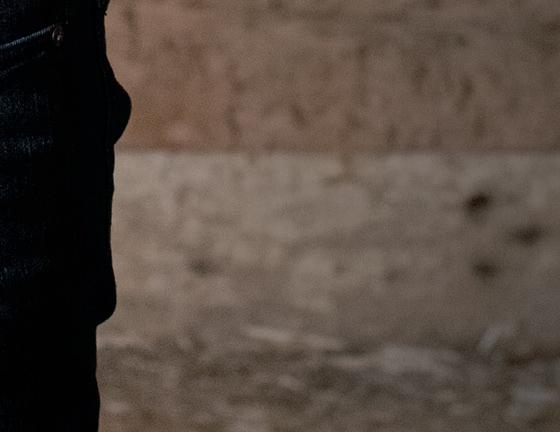


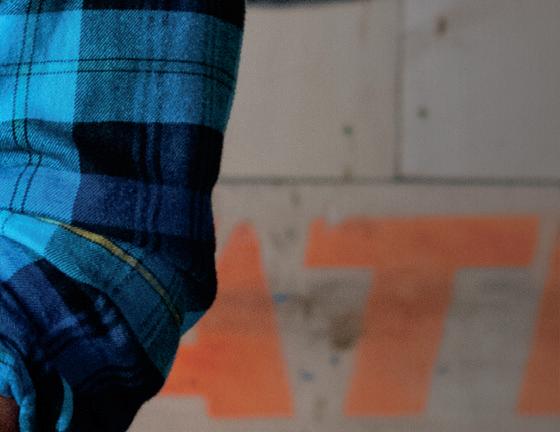
My biggest goal for this year is to defend my title at the World Axe Throwing Championship. Kristyn’s and my goal for The Lazy Axe remains the same as when we opened: to create a safe, high-quality, accessible, and unique experience that brings people together through the thrill of axe throwing.


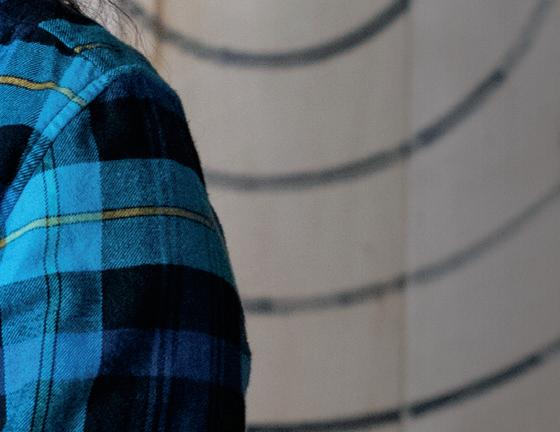


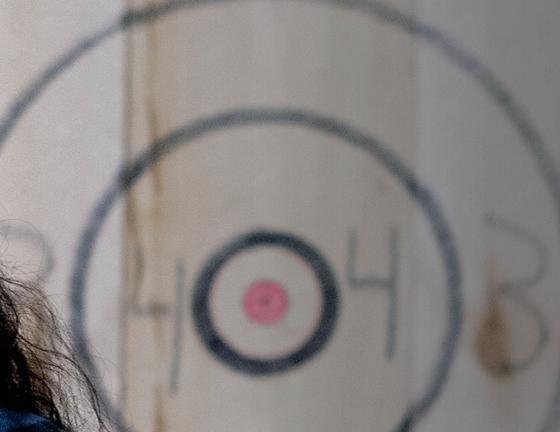



For more of our interview with Mark, visit bowdoin.edu/magazine.

 PHOTO: BETH MICKALONIS
MARK MIRASOL ’10
Mark Mirasol ’10, a professional axe thrower and 2021 big axe world champion, holds the imposing title of “Axe Master” at the Lazy Axe indoor throwing facility in Albany, New York, which he owns and operates with his wife, Kristyn.
ALUMNI NEWS AND UPDATES
PHOTO: BETH MICKALONIS
MARK MIRASOL ’10
Mark Mirasol ’10, a professional axe thrower and 2021 big axe world champion, holds the imposing title of “Axe Master” at the Lazy Axe indoor throwing facility in Albany, New York, which he owns and operates with his wife, Kristyn.
ALUMNI NEWS AND UPDATES
Connect
Connect
SEND US YOUR NEWS!
If there isn’t a class news entry for a class year, it’s because we didn’t receive any submissions for that year. We want to hear from you, and so do your classmates! Email classnews@bowdoin.edu or fill out a class news form on our website, bowdoin.edu/magazine
1948 Willis Barnstone: “I entered Bowdoin in 1944, at age sixteen, during World War II. I’m only a healthy ninety-four. Lots of sports each day to stay in shape. The world spins around a pin, and the happiest win.”
1955 Harvey Stephens has been honored by the Alumni Council with a Polar Bear Award in recognition of his steadfast service to the College. Harvey’s long-standing service is unmatched. He has represented his class and the College broadly for many years before records were kept of such work. His willingness to try new technologies and his dedication to traditional ways of connecting with classmates make him a wonderful partner to the development and alumni relations staff. Alumni and staff alike are motivated by his deep dedication to Bowdoin.
1958 Constantine Tsomides, principal and CEO of Tsomides Associates Architects Planners, has announced that his firm will commence construction in fall 2022 on a community commons expansion at the Applewood Retirement Community in Amherst, Massachusetts. The facility offers independent living options for people sixty-two and older. From tsomides.com, April 2, 2022.
1959 Reid Appleby:
“ William (Bill) Lehmberg passed away on February 3, 2022, at his home in Paradise Valley, Arizona, apparently due to complications of Crohn’s Disease. Bill was a very bright guy, with whom I spent many late nights at the Deke house playing bridge, poker, or hearts. I occasionally bummed a cigarette from him because I had never purchased a pack of ‘smokes.’ He knew that, but still would ask me when I was going to pay him back! You can see his obituary by googling ‘William M. Lehmberg, 2022.’”
Rod Forsman: “I lost my soulmate of forty-four years, Susan Forsman, to a brain tumor (glioblastoma) three years ago. After the worst period of my life, I am back. I remarried on January 1, and now live in Berlin, New Hampshire. I was [recently] outfitted with a dual-chamber pacemaker, a heartfelt change for the best Valentine’s Day possible.”
Kit Main: “It seems like ages since our 60th Reunion and joining John Bird and Mary Alice at one of the dinners. The pandemic has occupied a good deal of our non-activity in the intervening years, but we have stayed well and made a few car trips to friends and family in neighboring states. Sara is still nearly deaf, and I am still nearly blind, so she does the driving and I do the annoying. We will be in Bath for a family reunion this summer and will show Bowdoin to my teenaged grandkids. My eldest granddaughter is a freshman at Sarah Lawrence, following her mother’s education.”
1960 Doug Crabtree: “We will be at Bowdoin for the graduation of my granddaughter Ella Crabtree ’22
at the end of May. Hard to believe how long it has been since 1960!”
1962 Reunion
Peter Webster: “In 2014, our classmate John Sack retired from the practice of medicine in Seattle, Washington. He was one of the first surgeons in the Northwest to perform replant surgery and completed 160 surgeries over four decades. He served on the faculty of the University of Washington Medical School and was instrumental in training seventy-six hand fellows and hundreds of orthopedic residents, receiving four teaching awards during his tenure. Upon his retirement, the University Medical School created the annual John T. Sack Visiting Lectureship, which engages accomplished hand surgery professionals from throughout America for this nationally recognized educational effort.”
1967 Reunion
The Alumni Council has honored Tom Allen with the Alumni Footprints Award in recognition of his leadership in service to the common good. In keeping with the heralded words of Henry Wadsworth Longfellow, Class of 1825, the award recognizes a volunteer who has left “footprints on the sands of time” through professional, academic, and/or volunteer activities demonstrating leadership and a commitment to serving others.
Richard Bamberger: “A group of Zetes from the Class of 1967 assembled at Jo and Dave Comeau’s winter residence in Englewood, Florida, for conversation, exploration, good food and drink, and to do some preplanning for our 55th Reunion.”
Bob Crabtree: “In 2019, Bowdoin Magazine published a note about Roya Moussapour ’17 and me. We had discovered during a break in a rehearsal of the Me2/Orchestra, of which we were members, that we were both graduates of Bowdoin, with fifty years between us. She played violin and I the clarinet. Recently, on Sunday afternoon, January 23, we had the incredible experience of playing with nearly 100 musicians from the combined orchestras of Me2/— including Boston; Burlington, Vermont; Portland, Maine; and Manchester, New Hampshire—at Boston Symphony Hall. Over 1,400 attended the concert, and the performance made both Roya and me proud. Another example of the capacity of music to heal in troubled times! By the way, as a senior and a member of the Meddiebempsters, I’d last appeared on that stage singing ‘A Foggy Day in London Town!’ The [recent] event was, by far, the better performance!”
Frank McEvoy: “One item of note is that my best screenplay (I do have more than one in various stages of development—buzzword alert!), Shroud Trinity , has won a number of contests over the past six months: Airflix, Beyond the Curve, biff, the Cult Film Festival, EdiPlay, Multi Dimension Independent Film Festival, the Medusa, the NYC International Film Festival, Show Some Spark, and the Syd Field Academy Award. I have actors reading a scene [on YouTube]. One reader in a contest some years ago said, ‘This is like Raiders of the Lost Ark meets The Exorcist,’ which was a good distillation. One contest I won years ago saw it published on amazon.com.”
54 BOWDOIN MAGAZINE SPRING/SUMMER 2022 | CLASSNEWS@BOWDOIN.EDU
Remember
The following is a list of deaths reported to us since the previous issue. Full obituaries appear online at: obituaries.bowdoin.edu
Samuel M. Giveen ’42
February 17, 2021
George H. Gilmore ’46
February 5, 2022
Alan L. Michelson ’46
February 10, 2022
Jordan H. Wine ’46
December 7, 2021
Frederick W. Spaulding ’47
February 15, 2022
John Cummins ’48
December 11, 2021
Richard M. Frye ’49
December 18, 2021
Zeleke Bekele ’50
January 31, 2022
Fred R. Coryell ’50
April 24, 2022
Charles B. Douglas ’50
April 26, 2022
Charles M. Palmer ’50
January 12, 2022
Henry D. Sherrerd Jr. ’52
March 26, 2022
Harold W. Stuart Jr. ’52
May 3, 2022
Russell M. Hird ’53
February 10, 2022
Robert S. Linnell ’53
February 8, 2022
Robert M. Hurst ’54
May 3, 2022
Alden E. Ringquist ’54
April 11, 2022
Charles E. Skinner Jr. ’54
April 27, 2022
Spencer Apollonio ’55
March 8, 2022
William K. Cale ’55
April 30, 2022
Wallace R. Harper Jr. ’55
May 1, 2022
Thomas M. LaCourse ’55
February 20, 2022
Warren H. Greene Jr. ’56
April 15, 2022
Hartley S. Connett ’57
March 2, 2022
John C. Finn ’57
March 26, 2022
Peter G. Hastings ’57
March 5, 2022
David K. Hunter ’57
April 13, 2022
David R. Gosse ’58
February 22, 2022
Paul L. Estes ’59
April 23, 2022
William M. Lehmberg ’59
February 3, 2022
Harold J. Parmelee ’59
March 25, 2022
Elliot P. Putnam ’59 December 6, 2021
D. Peterson Hunter ’60 February 11, 2022
Frederick G. Myer Jr. ’60 March 9, 2022
William C. Preston ’61 March 23, 2022
Roger F. Riefler ’62 May 1, 2022
Edward R. Green ’65 March 12, 2022
Robert D. Bagley ’66 March 13, 2022
Roger Hinchliffe ’66 January 21, 2022
William F. Minnis ’66 September 7, 2021
Bo E. Hedlund ’68 March 8, 2021
David Van Varick ’68 March 12, 2022
Kenneth A. Lutte ’69
April 26, 2022
Roland E. Christy Jr. ’70
April 4, 2022
R. Kim Ficker ’70
April 29, 2022
Peter H. Mulcahy ’71
January 7, 2022
James H. Baird ’73
March 5, 2022
Charles S. Coxe II ’75
February 8, 2022
Myron M. Nakata ’77
January 24, 2022
Carolyn E. Swain Perez ’80
April 24, 2022
Daniel S. Hayes ’81
February 3, 2022
Matthew J. Tasley ’82
January 2, 2020
John R. Ward ’83
March 29, 2022
Brian C. Allaire ’86
October 1, 2020
Neil B. Minkoff ’90
May 4, 2022
Cheryl L. Silva ’90
April 4, 2022
Ryan Walsh-Martel ’03
March 4, 2022
FACULTY/STAFF
George Anderson
October 8, 2021
Danuta M. Barnard
April 17, 2022
A. Myrick Freeman III
February 6, 2022
John B. Ladley Jr.
March 14, 2022
Donna G. Sciascia
February 8, 2022
Arthur Stebbins Jr.
March 28, 2022
Joan D. Viles
March 24, 2022
Robert A. Walkling
March 2022
GRADUATE
Francis G. French G’65
January 3, 2022
Calvin Wolcott G’71
April 2, 2022
Robert G. Harnwell G’73
March 9, 2022
HONORARY
Madeleine K. Albright H’13
Bowdoin obituaries appear on a dedicated online site, rather than printed in these pages. Updated regularly, the improved obituary format allows additional features that we can’t offer in print, specifically the ability for classmates, families, and friends to post photos and remembrances.
PHOTO: ARTIST_CREDIT BOWDOIN MAGAZINE SPRING/SUMMER 2022 | CLASSNEWS@BOWDOIN.EDU 55
HOME SWEET REUNION
Dave Gleason ’70 helped plan an extra-special 50th Reunion in June with alumni from 1971 and 1972, and he didn’t have to travel far for the festivities.

ORDINARILY, WHEN WE CELEBRATE OUR FIVE-YEAR REUNIONS, we don’t know the other alumni on campus—we are too many years apart. This year is a wonderful opportunity to mix with other classes that we know much better.
AS A NAVY BRAT, I moved every three years. When I graduated from Bowdoin, I had enjoyed the wonderful town of Brunswick for four years and decided to make it my home. In 1973, I bought a four-unit apartment house on Federal Street. I enjoyed the experience so much that I decided to help others do the same thing. There is no greater satisfaction than helping a buyer procure the home of their dreams.
I AM NOT GOOD AT SITTING STILL FOR LONG, so, when I get up in the morning, I’m off to the office or to work on one of our investment properties. I have a wonderful wife, four children, two stepchildren, and four grandchildren, who make me proud every day. I am an avid sailor and own a boat with my brother, which we sail along the Maine coast every summer.
1969
Ted Reed has been honored by the Alumni Council with a Polar Bear Award in recognition of his steadfast service to the College. Over the years, Ted has served the Class of 1969 as longtime class agent, Reunion committee member—including chairing his 50th Reunion—and Leadership Gift Committee member. He has served the College community more broadly as a Campaign for Bowdoin volunteer, Alumni Club president, Alumni Fund director, BASIC/BRAVO volunteer, and as a member of the board of trustees. It seems that whenever Bowdoin calls, he answers, and he says yes. It is for these reasons that he is most deserving of this recognition.
online review, March 16, 2022. Paul reported in March that Accusation was a feat ured selection in the window of the Corner Bookstore in Manhattan.
1970
Accus ation , the latest book by Paul Batista , was recently included in a list of the top six legal thrillers of the past decade, as compiled by BookTrib, a leading source for book news and reviews. “Legal thrillers make for exciting reads because they combine the page-turning intensity of mystery books with the thrilling, rapidfire back-and-forth of courtroom drama. With options ranging from genre pillars to new releases and indies, the selections are perfect for both newcomers and veterans alike, and you’ll be rooting for these characters and following their stories, from their engaging beginnings to their shocking conclusions… and [they] will keep you guessing on the matter of ‘guilty or not.’” Accusation “tackles the #MeToo movement as actresses up for supporting roles in the films of a famous actor claim sexual harassment and subsequently begin to turn up dead.” From a BookTrib
Steve Schwartz is one of the producers of All the Old Knives, a new spy thriller released April 8 in select theaters and on Amazon Prime Video. Schwartz produced the film along with his wife, Paula Mae Schwartz, and Nick Wechsler and Matt Jackson. In the movie, Chris Pine and Thandie Newton play CIA agents and former lovers who are brought back together years after a failed mission. Reunited, they are forced to blur the lines between profession and passion in a tale of espionage, moral dilemmas, and deadly betrayal. The film, directed by Janus Metz, also stars Laurence Fishburne and Jonathan Pryce, and is based on the novel by Olen Steinhauer, who also wrote the screenplay. From a bowdoin.edu/news story, March 22, 2022.
1975
In 1971, when first-year student Saddie Smith ’75 arrived on campus, one of the first people she met was Greg McQuater ’72. Smith and McQuater formed an instant bond that has resulted in more than fifty years of wonderful friendship, despite living on separate coasts. They have been so aligned in life that their children were born on the very same day in 1986! McQuater returned to campus for Smith’s graduation in 1975, and they took their photo in front of the Walker Art Building. Now they serve on the Bowdoin College Alumni Council together and returned to campus in early April for their first volunteer spring conference. It was only fitting that they recreate their photo fifty years later!
56 BOWDOIN MAGAZINE SPRING/SUMMER 2022 | CLASSNEWS@BOWDOIN.EDU Connect
PHOTO: DENNIS GRIGGS
Dave Gleason ’70
Catching Up
1976Phil Gregory ’s role as cocounsel in the 2015 lawsuit Juliana v. the United States is documented in Youth v. Gov, a film that debuted on Netflix on April 29. The documentary examines the constitutional climate change case brought by twenty-one youths against the US government for violating their Fifth Amendment rights to life, liberty, property, and public trust resources. The plaintiffs in the case were represented by the nonprofit organization Our Children’s Trust, for which Gregory has served as pro bono counsel since 2010. From the youthvgovfilm.com website.

D. Ellen Shuman has been honored with the Alumni Service Award , presented each year in recognition of an individual’s record of volunteer service to the College. Shuman has been described as a pioneering leader and a steadfast servant of the College who has leveraged her extraordinary accomplishments at Bowdoin, and beyond, to help provide opportunity for others. In her two decades as a member of the board of trustees, she played vital roles as vice chair of the board and chair of the Audit Committee in the steady governance of the College, consistently prioritizing progress and performance over recognition. She also served for twenty-one years on the Investment Committee and was instrumental in selecting the College’s first investment professional, Paula Volent. Throughout her exceptionally successful career, Shuman also devoted significant time and expertise to supporting the careers of other alumnae, frequently organizing, sponsoring, and enthusiastically participating in networking events for Bowdoin
women. She served on Bowdoin’s Alumni Council from 1987 to 1991, becoming only the second woman president of the council. In 2006, Shuman established the Paul H. Douglas Scholarship Fund at the College, which specifically supports students who are committed to serving the common good. From a bowdoin.edu/news story, February 22, 2022.
1977 Reunion


Bill Elwell: “In 2019, my wife and I made a 13,500-mile road trip from Texas up through the Canadian Maritimes, across Labrador, and back home over the course of seventy-two days. We covered a lot of ground and got to see so many things. We found one unexpected Bowdoin connection on the trip. In the upper reaches of Labrador, we toured the hydroelectric facility at Churchill Falls. In the entrance to the power plant was a display case that held the book Bowdoin Boys in Labrador, which chronicles the story of two Bowdoin students who ventured up to the falls in 1891. The book is still in print and tells the tale of the grand adventure. The guide told the short story of their expedition, and I mentioned I was an alumnus. She said I was the first Bowdoin alum she had met. Farther down the road in Labrador City we stopped in a visitor center and there was a large plaque that also told the story of the Bowdoin Boys. We didn’t do the hike out to the falls from the road because it was raining, and the black flies were swarming pretty badly. After seeing the plaque in Labrador City, I wished we had done it anyway. Guess we’ll have to go back again. It will be in the fall next time, when it’s cold enough to suppress the bugs.”
When they were on campus recently as members of the Alumni Council during the Volunteer Spring Conference, Saddie

BOWDOIN MAGAZINE SPRING/SUMMER 2022 CLASSNEWS@BOWDOIN.EDU 57
Steve Schwartz ’70 and his wife, Paula Mae, two producers of the film All the Old Knives, pose on the red carpet at a special Los Angeles screening in early March.
In February, Carole and Robert Teeter ’67, Jane and John Michelmore ’67, Jo and Dave Comeau ’67, and Rick Bamberger ’67 got together at Dave and Jo’s winter home in Englewood, Florida, “for conversation, exploration, good food and drink, and pre-planning for our 55th Reunion.”
Smith ’75 and Greg McQuater ’72 celebrated their fifty-year friendship by recreating a photo from Saddie’s first year at Bowdoin in 1971.
Take the plunge!
Have you been putting off your financial and estate planning? We have a collection of resources, including videos and articles, available at bowdo.in/gp-resources that you may find helpful, in addition to other information at bowdoin.edu/gift-planning
If you would like to discuss including Bowdoin in your plans, contact Nancy Milam or Liz Armstrong at 207-725-3172. If you have already included the College in your plans, please let us know at bowdo.in/document-it
If you are sixty-five years old or older by June 30, 2024, documenting your plans for Bowdoin will count in the From Here campaign!

1978
American-British investment banker, philanthropist, and Bowdoin trustee emeritus John Studzinski has produced a series of blog posts aimed at sparking debate in a number of areas. “The Philanthropist’s View” tackles a variety of topics, from mentoring and the impact of technology to charity governance and volunteering. It is published through the Genesis Foundation, a nonprofit set up by Studzinski in 2001 to support young artists, directors, playwrights, actors, and musicians in the early stages of their professional lives. From a bowdoin.edu/news story, April 28, 2022.
1982
Reunion
Julie Bertola Cook, “an amateur beekeeper, recently moved from Westport, Connecticut—one of a number of towns to join the growing ‘pollinator pathway’ movement— to Bath, Maine. The group Maine Street Bath is updating its annual Downtown Flowers program to support bees, butterflies, and other pollinators. Many pollinators, which play a vital role in agricultural production and natural ecosystems, migrate, according to Cook. By planting native plants that produce the pollen and nectar that support pollinators, communities create ‘pit stops’ along their migration route. Bath will need to take additional steps to become an official pollinator pathway, including starting a steering committee to guide the project. Regardless of whether the city decides to become an official pathway, Cook said she’ll keep advocating for the bees and butterflies responsible for the flowers that will decorate Bath this summer.”
From a Brunswick, Maine, Times Record article, April 7, 2022.
Linda Nelson has received Bowdoin’s 2022 Common Good Award for being a singularly powerful advocate for the arts, the nonprofit sector, and the impact that cultural activities can have on communities in the state of Maine. Her pioneering work at the intersection of the arts and community development, which involved building an arts venue that became a beacon for Nelson’s town, island, and region, has helped transform the cultural landscape of the state. As a student at Bowdoin, Nelson was a vocal leader of the burgeoning communities of women and LGBTQ students on campus. Her work as a cofounder of the Women’s Resource Center and a member of the Gay Straight Alliance and the Bowdoin Women’s Association helped make Bowdoin a more welcoming place for her contemporaries and for the generations of women and LGBTQ students who followed. In 1999, while both a parttime resident of Stonington, Maine, and an executive of a New York City–based consulting firm, Nelson and her wife, Judith, along with two other women, began the process of restoring the Stonington Opera House, both as a physical landmark and as a vibrant community hub for arts and culture. Nelson served as founding executive director of Opera House Arts from 1998 to 2015. She relocated permanently to Stonington in 2001, becoming increasingly integral to the local community and to the network of arts and nonprofit organizations across the state in the years that followed. In addition to her work with the Stonington Opera House, Nelson served as a member and later as assistant director of the Maine Arts Commission and was deputy
1983
58 BOWDOIN MAGAZINE SPRING/SUMMER 2022 | CLASSNEWS@BOWDOIN.EDU Connect
THE CAMPAIGN FOR BOWDOIN THE CAMPAIGN FOR BOWDOIN
director of Portland Ovations. She currently serves as vice president and board member at the Maine Association of Nonprofits as well as being interim director, cofounder, and steering committee member at the Cultural Alliance of Maine. These experiences have helped Nelson understand and advocate for the ways in which the arts can bring people together and lift communities. From a bowdoin.edu/news story, February 22, 2022.
1985
Linda Dahlgren, “professor of large animal surgery at the VirginiaMaryland College of Veterinary Medicine (VMCVM), was awarded the 2021 Zoetis Award for Veterinary Research Excellence, which acknowledges researchers whose innovative studies have advanced the scientific standing of veterinary medicine. The award recognizes her work in comparative musculoskeletal research investigating regenerative medicine therapies for tendon, ligament, and joint disease in horses, and the translation of these findings to human medicine.” From a Virginia Tech X online news story, April 11, 2022.
income research at Bear Stearns, both in New York City. Committed to the study and advancement of economics and geopolitics, Doughty is a member of the Economic Club of New York, the International Institute for Strategic Studies, the Royal Institute of International Affairs, the Royal United Services Group, and the Foreign Policy Association. The BEC, established in 1932, is a nonpartisan organization that fosters engaging and well-informed dialogue on topics involving economics, finance, and public policy. Its secondary purpose is the development of friendships and the sharing of diverse perspectives.” From an R.M. Davis press release, May 5, 2022.
1989
1988
John D. Doughty, “chief investment officer with R.M. Davis, has been selected to join the membership of the Boston Economic Club (BEC). In joining the ninety-year-old organization, Doughty becomes the only member to live and work in Maine. A Maine native, Doughty joined R.M. Davis—Northern New England’s largest private wealth management firm, with over $6.5 billion in assets under management—in 2002 after serving as vice president of equity research at Credit Suisse First Boston and vice president of fixed
Ronald C. Brady has received the 2022 Bowdoin Distinguished Educator Award for his devotion to providing “transformational opportunities for underserved students.” Among the first generation of his family to graduate from college, Brady became a vocal and influential student leader on the Bowdoin campus. After graduation, Brady was awarded a Harry S. Truman Scholarship and earned a master’s degree in public affairs at Princeton University. Then he began a decorated career in education as assistant to the chancellor of the New York City public schools. He quickly and expertly gained knowledge about education strategy and organizational planning, knowledge that was soon put into practice in his next role with the State of New Jersey Department of Education, where he oversaw several state-operated school districts. From 2001 to 2003, Brady was employed by the school systems in Paterson, New Jersey, through a grant from the US Department of Education to
improve and increase the number of the city’s small learning academies. Perhaps Brady’s greatest and most impactful achievement came next, when, in 2007, recognizing the desperate need of underserved student populations and the power of a new educational model to lift those communities, he established Foundation Academies, a free charter school committed to creating “a wide range of intentional learning experiences in a joyful, inclusive, and culturally responsive environment” for schoolchildren in the economically depressed community of Trenton, New Jersey. From modest beginnings, Foundation Academies has grown to serve one thousand students from kindergarten through grade twelve, in four schools spread over two campuses. Brady built upon this success with his later work as executive director of Freedom Prep Charter Schools and as CEO of New Foundations Charter School. Brady has generously and enthusiastically shared his expertise, energy, and time with Bowdoin, serving as a member of the Alumni Council and then on the board of trustees, among many other volunteer roles. Brady was also a member of the Advisory Group for the THRIVE Program, using his considerable skills to help first-generation and low-income students achieve success at Bowdoin. Additionally, he served on the 2014 Presidential Search Committee and the 2016 Ad Hoc Committee on Inclusion. From a bowdoin.edu/news story, March 3, 2022.
an aggressive and deadly disease to humans, unleashing terror and a desperate attempt to find a cure before an apocalyptic pandemic ensues. A team of four specialists, directed by a mysterious government official, must identify a lethal prion and determine if its source is natural or engineered. Their mission turns even deadlier when they realize someone is hunting them. In this ingenious, breakneck thriller, the team’s adventures span the globe as they race to restore a delicate balance in nature—before madness tri umphs over science. Dr. Garrett Davis is a board-certified veterinary surgeon, having earned his bachelor’s degree at Bowdoin College, DVM at Cornell University, and surgical training at the University of Pennsylvania. He has been practicing surgery for over twenty years, authored multiple journal articles, spoken internationally at veterinary conferences, and currently is the director of the residency training program at the Red Bank Veterinary Hospital. He spends his free time cooking, writing, and traveling the world on adventures with his family. He lives in New Jersey with his wife, two children, and multiple pets. The Prion Paradigm is his first novel.’”
1994
Garrett Davis: “I have recently written and published a novel, The Prion Paradigm (GJD Publishing, 2022). This description is from the book jacket: ‘Crazed crocodiles at the Great Barrier Reef have transmitted
1993
Derek Plourde: “Happy to relay that I was appointed president and CEO of Charles River Bank, based in Medway, Massachusetts, on January 1, 2022. My wife, Laural, and I are also very proud of our older son, Riley, who will be pursuing an interactive media and game design degree at Champlain College in Burlington, Vermont, this fall. Our younger son, Hayden, continues to excel as a student at Whitinsville Christian School, where he will be a junior.”
BOWDOIN MAGAZINE SPRING/SUMMER 2022 | CLASSNEWS@BOWDOIN.EDU 59
On March 14, Peter Cipriano ’10 (in the bandana) and his partner, James Stout, of the New York Racquet and Tennis Club, won the 2022 US Open Racquets Doubles championship, defeating Ben Cawston and Mike Bailey from the Queens Club, London, in four games.

1999 Matthew Hyde
“has been appointed as Trinity College’s next dean of admissions and financial aid. Hyde currently serves as the assistant vice president for enrollment management and dean of admissions at Lafayette College, where he has led a team since 2011. Under his leadership, Lafayette grew the size of its applicant pool by 82 percent and increased other important recruitment benchmarks, including selectivity, student diversity, secondary/tertiary market growth, and yield rates. Throughout his time at Lafayette, Hyde helped to build and mentor teams within the department, uniting the efforts of the financial aid and admissions offices to manage modeling and forecasting strategies and to meet ambitious enrollment goals.” From a Trinity College online news story, April 5, 2022.
during statewide legislative hearings about her experiences and the need for bolder protections for birthing women. She has branded herself to be synonymous with trust, generosity, strength, and truth, and her neighbors have come to rely upon her to help meet their needs and bridge communication with the City.” From a TAPinto East Orange/Orange online news article, March 31, 2022.
2002 Reunion

Following a day of orthopedic surgery at Brown University/ Rhode Island Hospital in April, Devin Walsh ’10, Jonathan Schiller ’96, and Van Krueger ’10 took a breather for a Polar Bear photo op.

On March 19, surrounded by family and lifelong friends, Ryan O’Connell ’12, now Brother Theophilus, took his vows as a Maronite Monk of Adoration at Holy Trinity Monastery in Petersham, Massachusetts.

2000
Naiima HorsleyFauntleroy “has been named to the East Orange and Orange [New Jersey] 100 Women of Power and Progress list for 2022. Horsley-Fauntleroy, senior management at the City of East Orange, is proof a person can go away to receive an education and return to their community to use what they learned to enrich, give back, and grow the neighborhood that raised them. Horsley-Fauntleroy spearheads many initiatives throughout the city, most recently the COVID-19 rental relief program. From art projects to skate parks, all made possible by Community Development Block Grant funding, of which she is the manager, she is committed to developing the city that nurtured her. An ardent supporter of women, Horsley-Fauntleroy has a special knack for advocating for new moms in the workplace. She has testified
Cassie Flynn “was the featured speaker on activist/advocate night at Broken Box Mime Theater as part of their ‘With Words’ series, featuring a performing cast plus one honored guest that is a leader in their field. The speaker talks about the show, fields questions from the audience, and finds themes or questions that are resonant to all. Flynn is an internationally recognized expert on the treaty negotiations on climate change. She serves as the strategic advisor on climate change to the United Nations development programme’s administrator, [and is] also the head of the climate strategies and policies team and head of the climate promise in 120 countries. She is the creator of Mission 1.5 and the Peoples’ Climate Vote, which used gaming to become the world’s largest-ever survey on climate action. Previously, she served as a senior advisor to the Prime Minister of Fiji as COP23 president. Cassie gave a TED talk on connecting world leaders to climate activism in 2019 and has been a featured expert for CNN, the BBC, the Wall Street Journal, Le Monde, the New York Times, and other publications.” From a Broadway World online announcement, April 9, 2022.
Nicholas Miller: “My wife, Shelly Chessie Miller ’03, and I have
60 BOWDOIN MAGAZINE SPRING/SUMMER 2022 | CLASSNEWS@BOWDOIN.EDU Connect
Eileen Carter Williams ’90 said that “it’s always a good time when this group of Polar Bears gets together,” as they did in Naples, Florida, in December 2021. Pictured: Joe Williams ’88, Eileen, David Lyman ’88, Brad Rabitor ’88, Rob DeFreitas ’88, Sarah Smith DeFreitas ’88, Jeff Battiston ’88, and David Mazzella ’88.
produced a movie that will premiere in limited theaters and online streaming [April 8]. It’s called Coast.”
2003

Joshua Police
“has been selected by Boston Mutual Life Insurance Company to run a new sales department. Police will be the executive vice president in charge of the Canton, Massachusetts–based company’s business development and One Company Solutions Strategic Business Center. The center will oversee distribution of individual life insurance products and workplace product sales and distribution. It will work to build on Boston Mutual’s existing presence in the worksite market in New England. Police has been Boston Mutual’s vice president for market strategies. He began working for the company in 2008.” From a Think Advisor online news announcement, April 29, 2022.
2005
Kevin “KAYR”
Robinson spoke on campus in April, telling students that financial capital, intellectual capital, and social capital were all necessary to achieving “transformational wealth.” KAYR—who is founder of KAYJAY consulting, a licensed real estate agent, a member of the Homeowners Association of Philadelphia, and a life coach—shared his wisdom in a talk titled “How to Achieve Financial Independence.” He covered the scope of his life from his humble beginnings struggling with financial, food, and housing insecurity to owning a multimillion-dollar real estate investment company. After a conversation spanning everything from the American Dream to “rainy day” funds to proactive budgeting, KAYR said he hopes his lessons will be
transferable and valuable to Bowdoin students. From a bowdoin.edu/news story, April 26, 2022.
2007 Reunion
The Hight Ford Dealership in Skowhegan, Maine, part of the Hight Family of Dealerships owned by Sam Hight, “has once again been recognized with two of the highest awards given by Ford Motor Company, for the third consecutive year. The dealership has received the Ford Motor Company President’s Award and the One Ford Elite Award for 2021, after previously winning both awards in 2020, 2019, and the President’s Award in 2016. The President’s Award is one of Ford’s most prestigious awards, recognizing dealers who have achieved the highest levels of customer satisfaction and sales performance. The Hight Family of Dealerships operates the oldest family-owned dealership in New England. Starting in 1911, Walter Hight began selling Model T Fords in Skowhegan, and continued to do so through four generations, two world wars, and two pandemics. In 2011, the National Automobile Association awarded Hight Family of Dealerships the Century Award—given to dealers that have owned and operated businesses in the industry continuously under one family for 100 years. Since 1947, only fifty-two dealers have earned the Century Award, and Hight is the only Century Award winner in New England.” From a Hight Ford Dealership press release, April 8, 2022.
You are From Here.
Once a Polar Bear, always a Polar Bear. Stay engaged with Bowdoin in whatever way works for you—volunteer, attend an event, make a gift, or tune into an online program. All of it matters for the campaign, and more importantly, keeps the bonds of the Bowdoin community strong.

Find
bowdoin.edu/fromhere
BOWDOIN MAGAZINE SPRING/SUMMER 2022 CLASSNEWS@BOWDOIN.EDU 61
Jenny Adu has been honored by the Alumni Council with the Foot Soldier of Bowdoin Award in recognition of her tremendous partnership with the staff in development and alumni relations. Over the past two years—through the pandemic and the growth of her family—she out more about how you can engage by scanning this code, or visit bowdo.in/engage
EYES OF THE WORLD
Mariya Ilyas ’13 had her sights set on a completely different career before finding her calling as a diplomat.
WHEN I ARRIVED IN BRUNSWICK, I was passionate about math and law because I wanted to become an astronaut or a lawyer. I majored in math and minored in government studies, but sociology, religion, acting, and forensic science gave me new lenses to understand the world and the human spirit.
I JOINED THE US DEPARTMENT OF STATE as a diplomat in fall 2018. I am serving my nation because it has given me a voice, an aspiration, and opportunities. I was eight years old when my family immigrated to the US from Pakistan. That moment in time profoundly changed the trajectory of my life: from being a young girl growing up in a small village expected to be a housewife to becoming an educated woman with the ability to chart my own future. Attending public schools, growing up Muslim in the nation’s capital, and attaining a liberal arts education have given me a unique appreciation for diversity, service, and identity. My father, who took a leap of faith to uproot himself and start a new life in America; my teachers and friends, who have supported my development as a human being; and my travels in foreign lands connecting with others in different languages have inspired me to lead a life of mercy and optimism.

For more of our interview with Mariya, visit bowdoin.edu/magazine.
was instrumental in planning and implementing a meaningful celebration of fifty years of women at Bowdoin. Her work was enjoyed by fellow alumnae and hundreds of members of the Bowdoin and Brunswick community. Her unflappability, creativity, good humor, and the remarkable way she motivates others is truly unmatched. Bowdoin is grateful for all that she does and is pleased to recognize her for her truly distinguished service. The Foot Soldier Award is presented to “one who exemplifies the role of a foot soldier of Bowdoin through his or her work” for the College. It was created through the generosity of David Z. Webster of the Class of 1957. Along with the recognition, a scholarship will be awarded to a deserving Bowdoin student in the recipient’s name through the Foot Soldier of Bowdoin Scholarship Fund.
investment firm, has been named to the 2022 Midas Brink List. The list is selected by TrueBridge Capital Partners and Forbes, and “highlights talented, emerging investors making a name for themselves in the increasingly competitive world of venture capital. Nominees are evaluated based on qualitative and quantitative measures that weigh an investor’s momentum, position, reputation, and other variables. This year, they once again enlisted the expertise of a panel of investors previously named to the Brink List to provide their insight into the selection process. The 2022 list of up-and-coming investors represents a diverse range of problem-solvers whose unique experiences, backgrounds, and expertise position them to take center stage in the world of venture capital.” From a Forbes online feature article, April 12, 2022.
2008
David K. Thomson’s recently released book, Bonds of War: How Civil War Financial Agents Sold the World on the Union, is “a fascinating work of financial and political history during the Civil War era that shows how the marketing and sale of bonds crossed the Atlantic to Europe and beyond, helping ensure foreign countries’ vested interest in the Union’s success. Indeed, David K. Thomson demonstrates how Europe, and ultimately all corners of the globe, grew deeply interdependent on American finance during and in the immediate aftermath of the American Civil War.” The book was also featured in the New York Times article “How Civil War History Explains Memestocks,” published on April 2, 2022. From amazon.com.
Nick Tomaino, founder and general partner of 1confirmation, a leading cryptocurrency-focused
2010
Devin Walsh: “2010 classmates
Van Krueger and Devin Walsh are completing their orthopedic surgery training at Brown University with fellow Bowdoin alum and pediatric orthopedic surgeon Jonathan Schiller ’96.”
2012
Reunion
La’Shaye Ervin Cobley recently returned to Bowdoin to give two public talks: one about women in science, and another on how studying the nitrogen cycle in cities can reveal income disparities. Cobley majored in biology and Africana studies before earning a PhD in ecology and evolutionary biology from the University of Utah. She currently works at the California Air Resources Board, where she helps the state clean its air through “strong regulations grounded in science,” she said. During her two days on
62 BOWDOIN MAGAZINE SPRING/SUMMER 2022 | CLASSNEWS@BOWDOIN.EDU Connect
Mariya Ilyas ’13
Catching Up
PHOTO: JABER AL AZMEH
campus, Cobley first sat down with Sara Nelson ’22 to speak about her experiences as a graduate student, teacher, and climate policy analyst. Her interview served as the kick-off to a new series, “Meet the Bowdoin Women of STEM.” In their discussion, Cobley touched on many topics, including how to break into science and environmental policy, the role of socioeconomics in urban ecology, and her personal experience navigating the science world as a Black woman. The following day, Cobley was invited to give a seminar talk hosted by the biology department for scientists from outside Bowdoin. In her presentation, she made a case both for studying urban ecology and for recognizing the role that class and income play in ecological studies From a bowdoin.edu/news story, April 11, 2022.
Sherrone Torres has been honored by the Alumni Council with the Young Alumni Service Award in recognition of distinguished and outstanding service to Bowdoin. In the ten years since she graduated, she has been a steadfast volunteer, giving time for the College in many different ways despite her demanding career as a lawyer. She has stayed connected to the College as a BCAN Advisor, Sophomore Bootcamp volunteer, mock interviewer for the Office of Career Exploration and Development, and served with distinction as a chair of the AF/AM/50 celebration. She has formally and informally served as a mentor for countless young alumni as a leader of the Bowdoin Multicultural Alumni Network of New York and continues her service in representing multicultural alumni in her new role as vice president of the Bowdoin College Black Alumni Association. As a volunteer, she is known for her professionalism,
organization, and seemingly endless capacity to give back. She connects with alumni and students in a way that is truly meaningful.
2013Tasha Sandoval
“is one of twentyfive student journalists to receive the 2022 ProPublica student conference stipend to attend conferences including NABJ, AAJA, ONA, and IRE. This year’s recipients were chosen from more than 125 applicants. Each of the talented journalists will receive a $750 stipend to attend a virtual or in-person conference in 2022. The stipend program is part of ProPublica’s ongoing efforts to help make it easier for journalists from underrepresented communities to take advantage of everything the conferences offer. Sandoval is a Colombian and Cuban American writer and journalist based in New York City. She started pursuing journalism at the Bogotá Post, an English-language outlet in Colombia, after six years of working in higher education and international admissions. She is currently a bilingual master’s student at the Craig Newmark Graduate School of Journalism at CUNY, where she is specializing in audio journalism. She is a spring 2022 intern for Univision’s El Detector, the first Spanishlanguage fact-checking platform in the US.” From a ProPublica online news article, April 5, 2022.
2016 Sophie Sawyers
“has been hired as the new director of education at the Sun Valley Museum of Art (SVMoA) in Sun Valley, Idaho. Sawyers said as the director of education she is excited about the opportunity to support and learn from committed, creative educators in the community and engage with learners of all ages.
Before moving to the Wood River Valley, Sawyers was a third-grade teacher of math, history, and English language arts in New York City. Within education, her interests are culturally responsive and social and emotional learning. Sawyers, who joined the education department at SVMoA in October 2021, began her new responsibilities on March 1. In addition to building upon existing relationships with Blaine County educators while fostering new ones, she looks forward to promoting opportunities to explore museum exhibitions and continuing to develop SVMoA’s Classroom Enrichment Program and scholarships for students and teachers.” From a Boise, Idaho, Idaho Business Review article, April 25, 2022.
2018Gil Roddy has been honored by the Alumni Council with the Young Alumni Service Award in recognition of distinguished and outstanding service to Bowdoin. During his short tenure as an alum of Bowdoin, he has established himself as a dedicated and reliable volunteer with a seemingly endless enthusiasm for all things Bowdoin. He has stayed connected to his class as an associate class agent and serves the College more broadly as a BRAVO volunteer with admissions and as an important networking contact for the Office of Career Exploration and Development. Gil has been described as an “exemplary agent” and the prime example of why peer-to-peer outreach is so important. He connects with his classmates in a way that is meaningful, authentic, and motivational. He is a dedicated ambassador and always offers new insights and creative suggestions to the great benefit of the College.
2021
Jasper Gordon has rolled out quite a project for himself, and he hopes it gives rise to creativity, exploration, and delicious pizza. A Million Pizza Challenge, billed as “the greatest pizza challenge to ever hit the internet—maybe,” came out of Gordon’s long-standing enjoyment of making and eating pizza and his quest to understand what makes the best pizza. In early February, Gordon posted a video introducing the challenge. Every week since then, he and his friends have produced a video of themselves making a pie. Each YouTube view is counted as “a pizza” toward the million-pizza goal. Gordon says the project’s objectives are “to make more pizza, to make better pizza, and to have fun doing it together as friends.” From a bowdoin.edu/news story, March 22, 2022.
Mohamed Kilani, “a Spanish teacher intern at Lincoln Middle School, was recognized on April 1 as a Preservice Teacher of the Year at the Educators Rising Conference hosted by Thomas College in Waterville. Kilani and Ivy Robinson, a student teacher at Jonesport Elementary School, were both selected as Preservice Teacher of the Year and received $1,000 for their future classrooms. There were twenty applications of seniors in a teacher preparation program across Maine for the inaugural award, which was judged by Maine County and State Teachers of the Year. Successful candidates had to have a passion for teaching, a drive for self-improvement, strong communication skills, and adaptability. The judges praised Kilani, who has been working with Lincoln Spanish teacher Sheila Conlan since January, for his teaching skills.” From a Portland Public Schools News article, April 15, 2022.
BOWDOIN MAGAZINE SPRING/SUMMER 2022 | CLASSNEWS@BOWDOIN.EDU 63
KEEPING IT SIMPLE
Maine Island Trail Association (MITA) launched as a grassroots effort in 1988 by people seeking to visit and steward the uninhabited islands of Maine. While friend groups exist for many public parks, there are few—if any—others where a handshake agreement between one hundred disparate landowners and thousands of users and volunteers created a nationally known recreational entity.
PUBLIC AND PRIVATE
The trail has steadily grown to encompass the entire coast of Maine—from New Hampshire to Canada—and to include well over 200 islands and mainland sites. Island owners recognize that MITA’s straightforward and time-honored system works toward protecting their property. While original trail islands were public property, private islands have been added and now eclipse the number of public islands.
FINDING YOUR WAY
The Maine Island Trail Guidebook is the best resource for exploring the trail, but it can’t be found at your local bookstore. MITA encourages stewards and users of Maine’s coast to support their work through annual membership. (How you get the guidebook!) Dues fund stewardship, education, and preservation management.
SHAKE ON IT
GETTING STARTED
The idea of a coastal water trail was born in the late ’70s after a State of Maine land survey of the uninhabited coastal islands determined the state held title to some 1,300 unclaimed islands, rocks, ledges, and low-water bars. In the mid ’80s, the state collaborated with the nonprofit Island Institute to evaluate their recreational potential. Dave Getchell Sr., a founder of MITA, identified some forty suitable public islands, which formed the original Maine Island Trail.
A FIRST OF ITS KIND
“In studying this bounty [of islands],” Dave wrote in 1987, “it occurred to me that here was a rare chance to develop an outstanding waterway for small boats that would use the stateowned islands for overnight stops, similar to the way hikers use pathways like the Appalachian Trail.” This was the inception of what recreational boaters today call a water trail—a concept replicated over five hundred times in North America.
“I love the handshake model that underpins the Maine Island Trail,” says Brian Marcaurelle ’01, program director at MITA. “The trail is built on a foundation of generosity and trust, not contracts. Despite all the ways that might fail, it has stood the test of time. It’s wonderfully simple and distinctly Maine, and it has served MITA, property owners, and island-users well.” Marcaurelle oversees MITA’s stewardship operations, including caring for the properties on the trail, developing and maintaining landowner relationships, and managing partnerships with land trusts and the state. “I was a biology and environmental studies major at Bowdoin,” Marcaurelle says. “It was the outdoors that drew me to Maine, and Bowdoin only solidified my passion for the environment.” After graduating from the Yale School of the Environment, where his studies focused on balancing the use and preservation of land, Marcaurelle returned to Maine and began volunteering with MITA, which led to his full-time role.
For more on the Maine Island Trail Association, visit mita.org.
64 BOWDOIN MAGAZINE SPRING/SUMMER 2022 CLASSNEWS@BOWDOIN.EDU Here
The Maine Island Trail—which National Geographic dubbed one of the “50 Best American Adventures”— is the largest water trail association in North America and a model for other trails across the country.
PHOTO: FRED FIELD
BOWDOIN ON THE TRAIL
Bowdoin owns two islands on the Maine Island Trail, Merritt Island (pictured, used by the Bowdoin Outing Club) and Wyer Island (part of the Schiller Coastal Studies Center), that are open to the public. “MITA keeps a watchful eye over the islands throughout the boating season while also helping to keep trails clear and the shoreline clean of marine debris,” says MITA program director Brian Marcaurelle ’01. “It’s a great example of how the trail works and how it can benefit all involved.”

Bowdoin Magazine Bowdoin College Brunswick, Maine 04011 NON-PROFIT U.S.POSTAGE PAID BOWDOIN COLLEGE
“In my story, I hope that others can see and identify with the struggles, the inevitable ups and downs, the forward motion and setbacks, and somehow see that we have much more in common than we do differences, understand that we all have fears and insecurities and can grow to believe that all things are possible if you dare to dream big and step out in faith.”
—LAURIE GAGNON LACHANCE ’83, P’13, H’22, COMMENCEMENT WEEKEND REMARKS










 On Saturday, May 7, students gathered on the Brunswick Quad for Holi, an ancient and hopeful Hindu festival that celebrates the colors and promise of springtime. The South Asian Students Association sponsored the event, which offered samosas, kulfi, gelato, tag, water fights, and a plethora of colorful dance and revelry.
Photo by Andrew Estey
On Saturday, May 7, students gathered on the Brunswick Quad for Holi, an ancient and hopeful Hindu festival that celebrates the colors and promise of springtime. The South Asian Students Association sponsored the event, which offered samosas, kulfi, gelato, tag, water fights, and a plethora of colorful dance and revelry.
Photo by Andrew Estey



 PHOTO: CIDGY BOSSUET
PHOTO: CIDGY BOSSUET






 Mckesson ’07
Mckesson ’07



































































































 ILLUSTRATION: HARRY CAMPBELL; PHOTO: TRISTAN SPINSKI
ILLUSTRATION: HARRY CAMPBELL; PHOTO: TRISTAN SPINSKI














































 PHOTO: BETH MICKALONIS
MARK MIRASOL ’10
Mark Mirasol ’10, a professional axe thrower and 2021 big axe world champion, holds the imposing title of “Axe Master” at the Lazy Axe indoor throwing facility in Albany, New York, which he owns and operates with his wife, Kristyn.
ALUMNI NEWS AND UPDATES
PHOTO: BETH MICKALONIS
MARK MIRASOL ’10
Mark Mirasol ’10, a professional axe thrower and 2021 big axe world champion, holds the imposing title of “Axe Master” at the Lazy Axe indoor throwing facility in Albany, New York, which he owns and operates with his wife, Kristyn.
ALUMNI NEWS AND UPDATES













